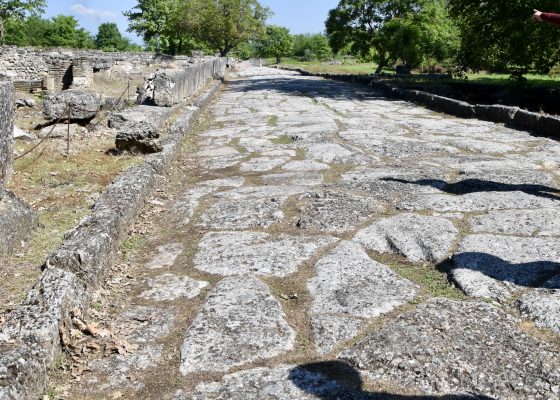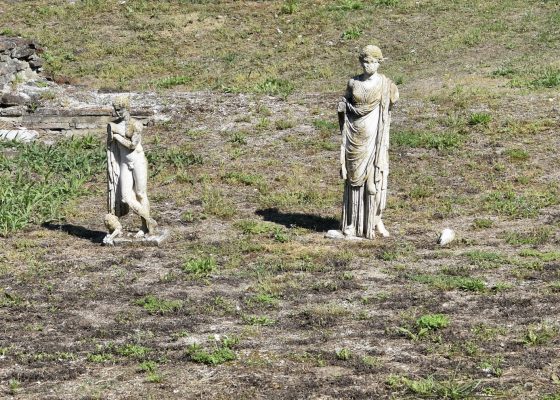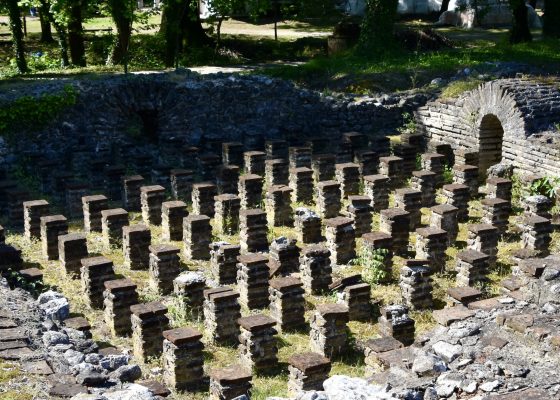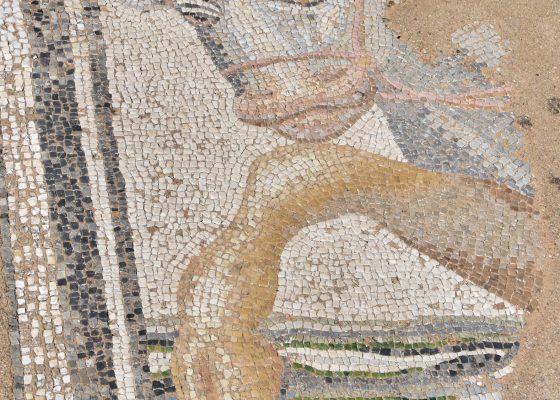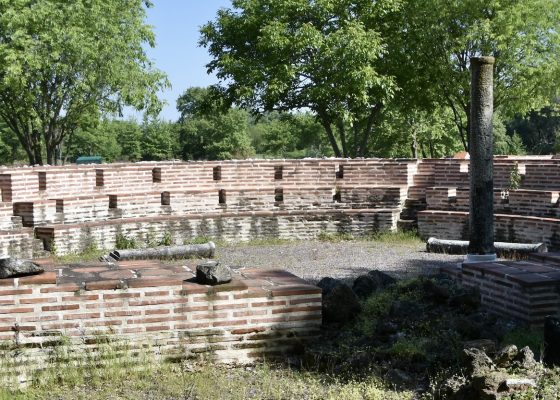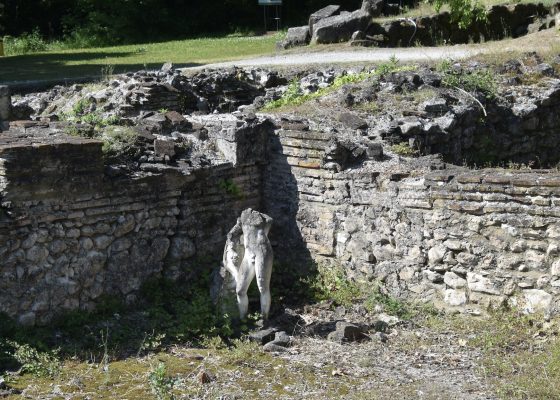Dion & Mount Olympus
In the last three posts from the 2023 Adventures Abroad Via Egnatia tour led by Victor Romagnoli we have been ensconced in the world of the ancient Macedonians. First in the city of Thessaloniki, then Pella, birthplace of Alexander the Great and thirdly Vergina where we were dazzled by the wealth found in the tomb of Philip of Macedon, Alexander’s father. When Victor and I were planning this tour it was always our intention that we would feature both man made and natural attractions in roughly the same proportions. In this post we will combine both as we visit the home of the Greek gods, Mount Olympus and the wondrous archaeological site of Dion just below it. Once again, it is a day I have long been looking forward to and I hope you’ll join me in our explorations.
When most people think of ancient Greece and the societies that emerged there starting in the Bronze Age, they tend to think of the Peloponnesse, Attica or the island of Crete. This is where the Minoan and Mycenaean civilizations first arose to be followed by the city states of places like Athens, Sparta, Corinth and Thebes. As we have been finding out on this tour, the Macedonians were far removed from these places and not even considered to be Greeks by many of their southern counterparts. So how then did the home of the Greek gods come to be situated on the border of Macedonia and Thessaly and not somewhere closer to where most of the Greeks actually lived? I know that this was a question I asked myself many years ago when I first noted the location of Mount Olympus on a map.
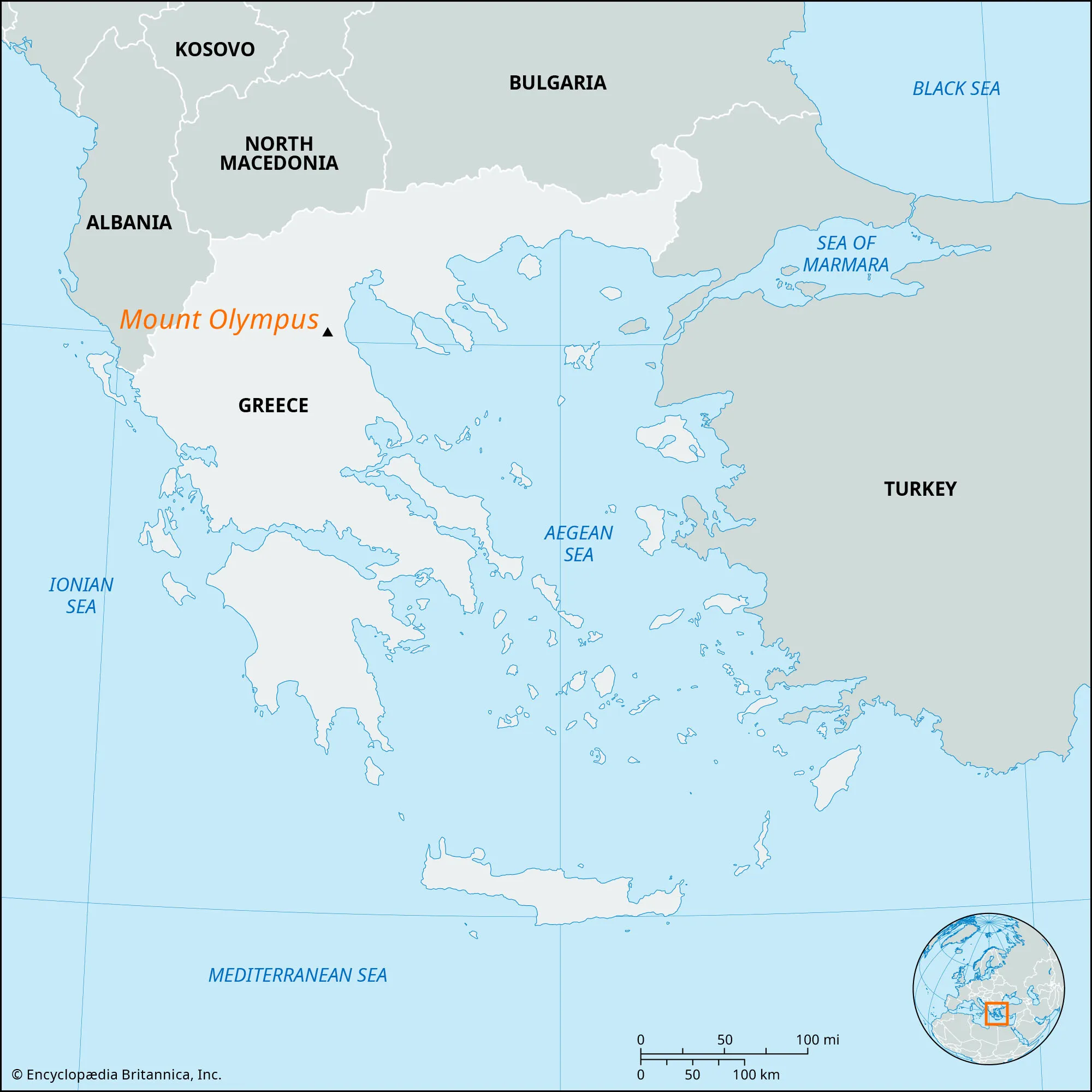
The answer lies in both the natural attributes of Mount Olympus and the mythology associated with it. It is the highest mountain in Greece at 2,918 metres (9,573 feet) and its location so close to the Aegean Sea gives it a unique climate that often leaves the peak shrouded in clouds and frequented by storms. The oldest known written accounts about Mount Olympus come from Hesiod and Homer who described it as the place where the Titanomachy took place. This was an epic ten year battle between the young Olympians and the older Titans with Zeus and his allies emerging victorious and creating Mount Olympus as the site of their home. All twelve of the Greek gods had palaces there with Zeus’ being on the summit. It is a place that has inspired awe in mere mortals ever since and I am no exception as I get my first look at this fabled mountain.

Yes there are the clouds as predicted, but somehow I never expected it to look so formidable. When one thinks of Greece it is usually about hot weather and balmy breezes, not snow covered mountains. Yet that’s exactly what I’m looking at and I can begin to appreciate why this place took on the aura it did. One thing this photo does not do justice to is the fact that Mount Olympus can be seen from great distances in all directions and that adds to its overall majesty.
We arrived at the small village of Litichoro on the flanks of Mount Olympus after leaving Vergina and stayed two nights at the Ktima Faki hotel which has a wonderful location just outside the village. After three nights in the centre of Thessaloniki this was a great contrast, breathing fresh mountain air with the scent of pine.
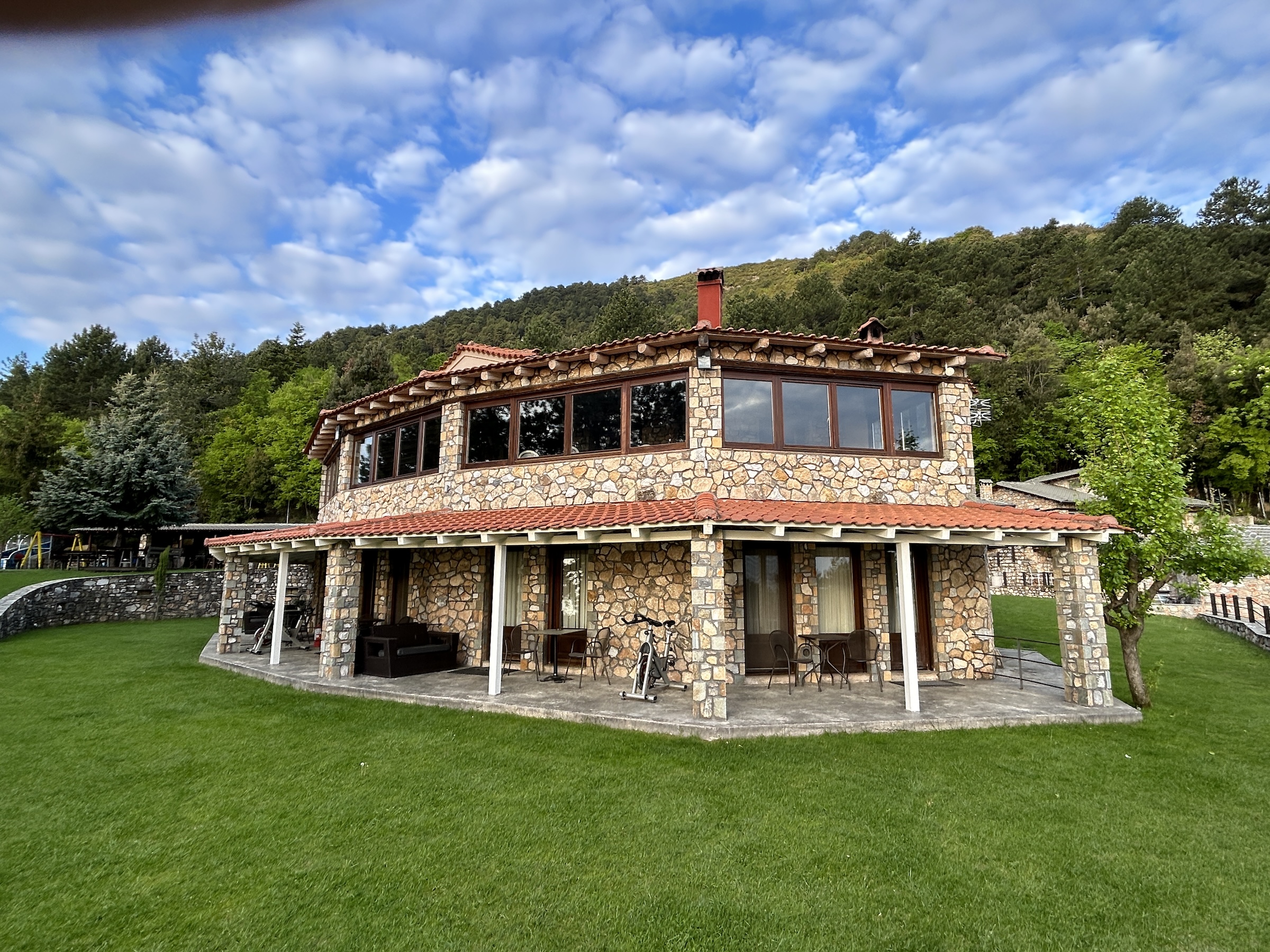
There was a swimming pool to relax by before our evening meal.
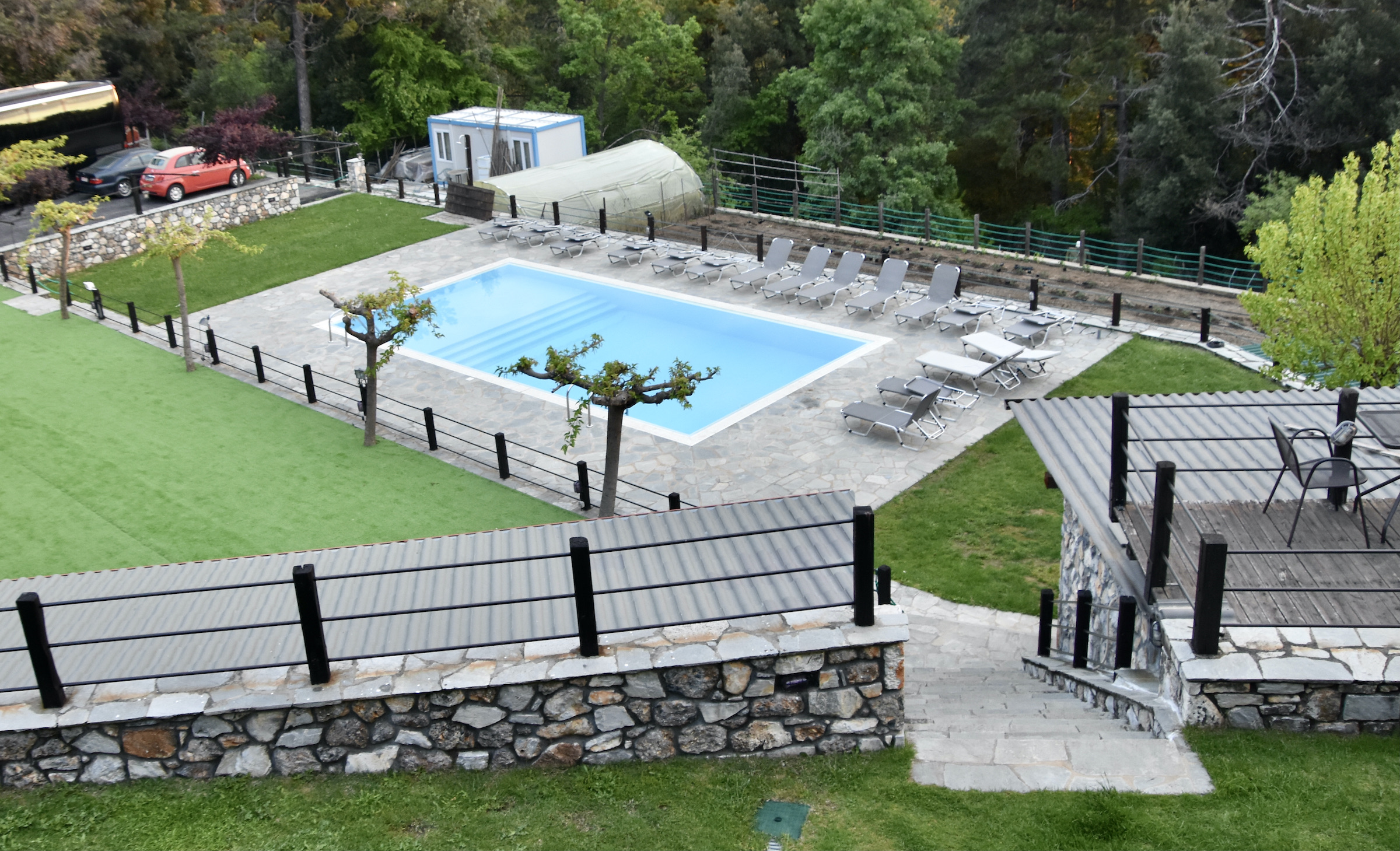
Dion
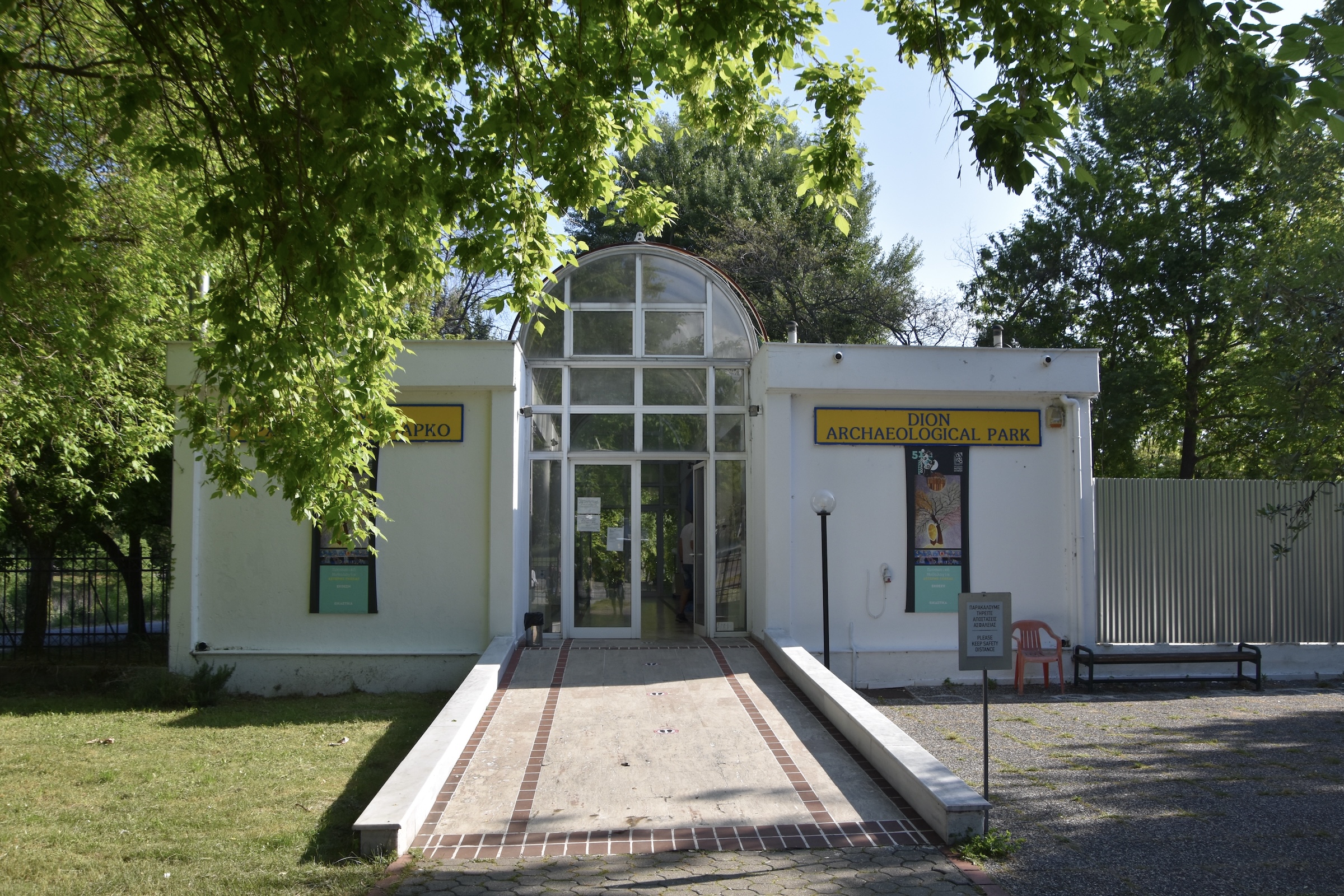
We went to quite a number of archaeological sites on the Via Egnatia tour and I enjoyed them all, but the one that sticks out the most in my mind is Dion. It was the spiritual centre of the Macedonian world with sanctuaries established here to Zeus aka Dion, Demeter, Artemis, Asclepius and Isis. It was here that Alexander the Great sacrificed to Zeus before setting out to take on the Persians. During the Macedonian era it remained essentially a place of pilgrimage, but after the Romans took over in 169 BC a city was built near to the sanctuaries so the archaeological site consists of two distinct parts, the Hellenic and the Roman. There’s also a very interesting museum off site that we’ll visit later.
The thing that made Dion stand out was both its proximity to Mount Olympus which you can see from many places on the site and its natural beauty. There are ancient trees, many ponds and waterways and the birdsong is glorious. Best of all was the fact that we were the only ones here giving it an enhanced sense of quietude and peace. Here’s Alison walking to the sanctuaries of Dion.
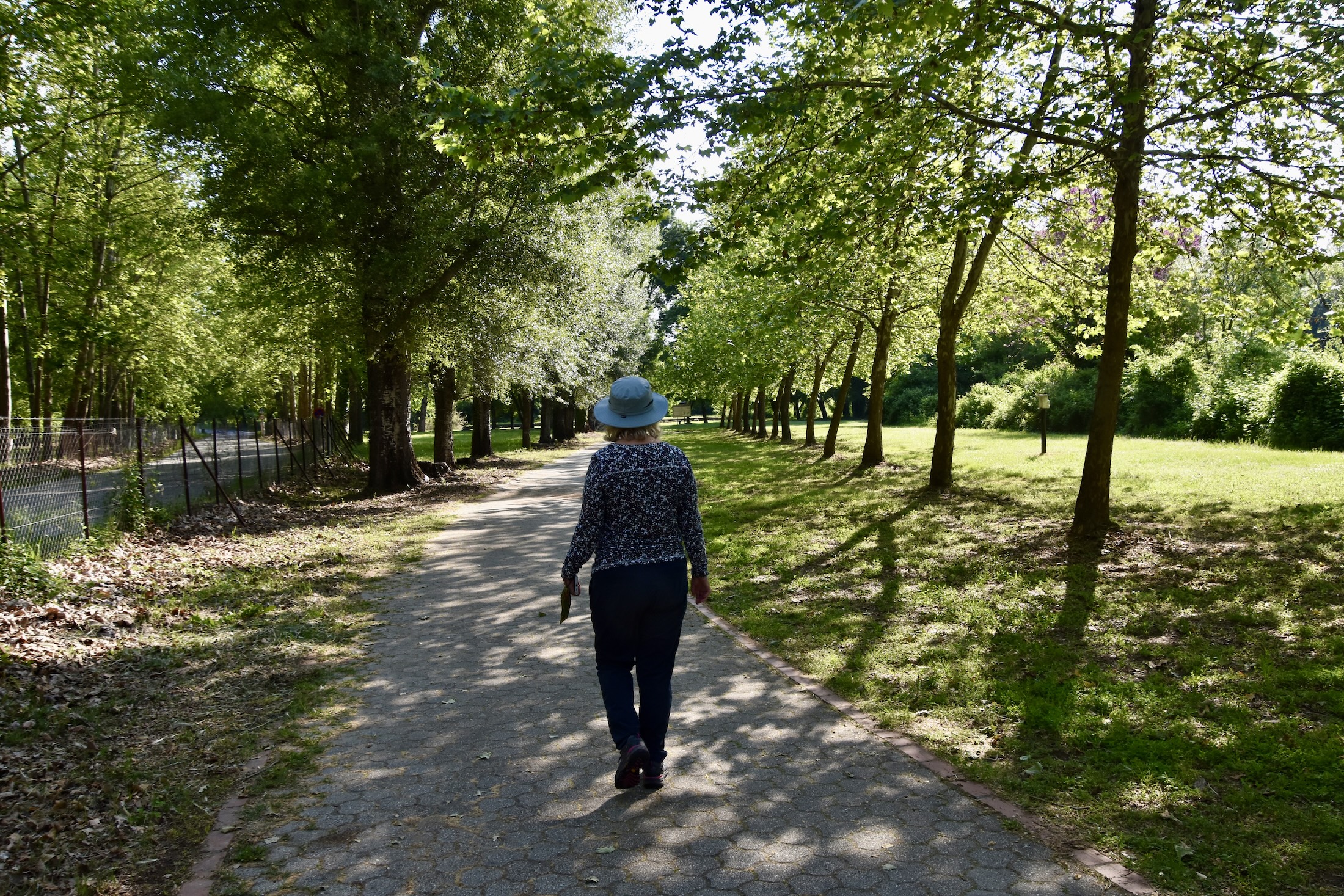
Like Pella, Dion was once almost on the coast of the Aegean Sea and after the site was abandoned the sanctuaries were covered with silt and gradually buried. When the site was rediscovered, archaeologists removed the soil. but did little other restoration.
Our local guide Nikos explains this standing before the Sanctuary of Demeter which is the oldest one at Dion and was in use from 600 BCE to the 4th century when the Christians put a stop to the worship of the Olympians.
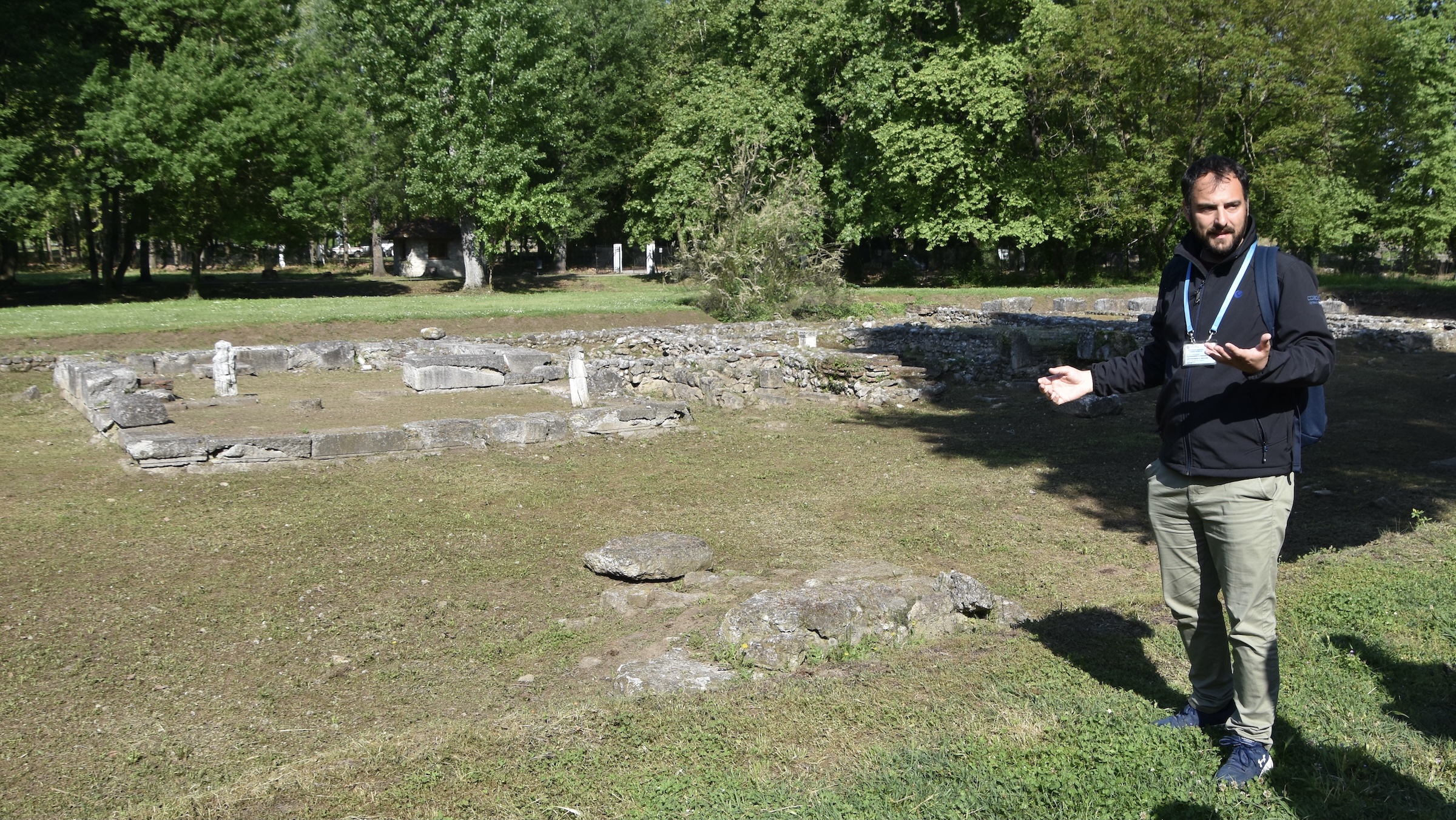
Here’s a closer look. The statues found on site have been left exactly as they were unearthed, although these are replicas with the originals in the museum. Demeter is closely associated with the Eleusinian Mysteries about which we still know next to nothing. If you thought the Masons were secretive, the inductees to the Eleusinian Mysteries make them look like whistle blowers. Swine, probably piglets were offered to Demeter in hopes of securing a good growing season.
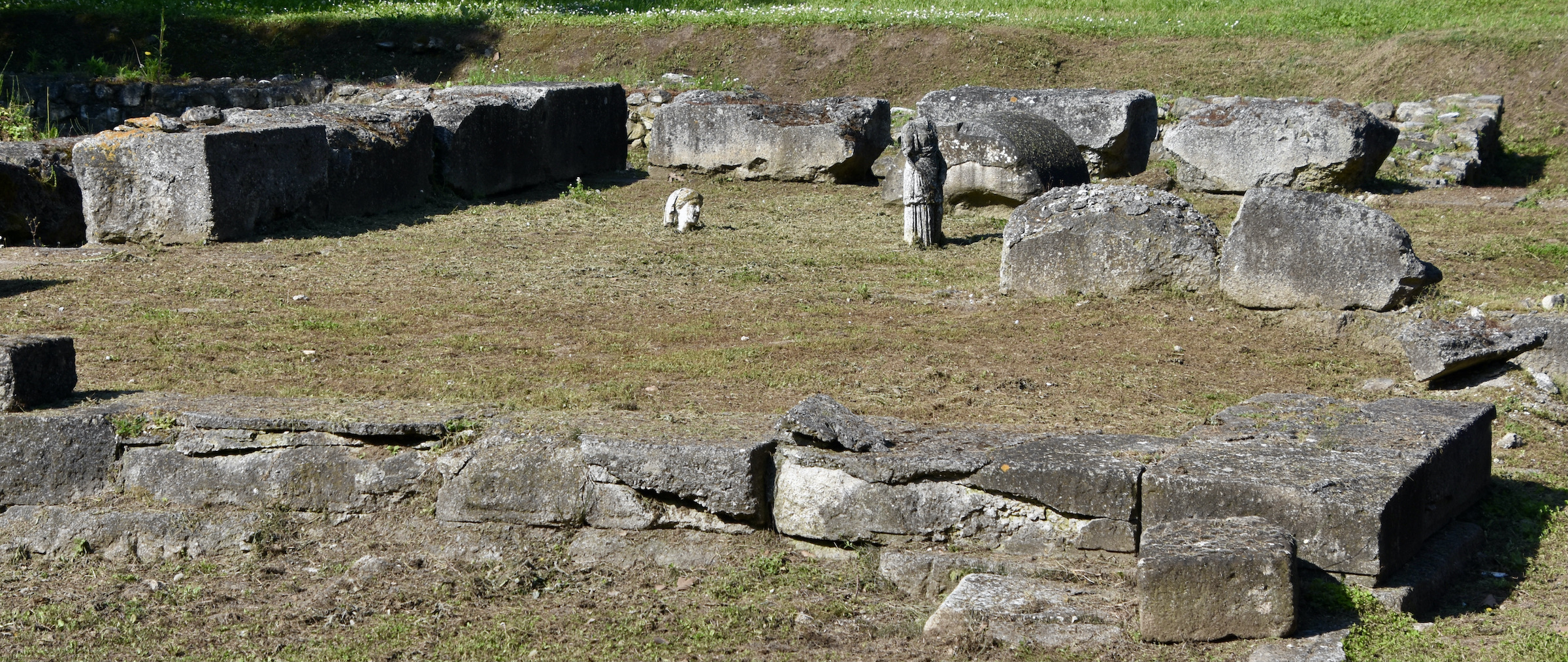
Here’s an even closer look. There’s something haunting about this.
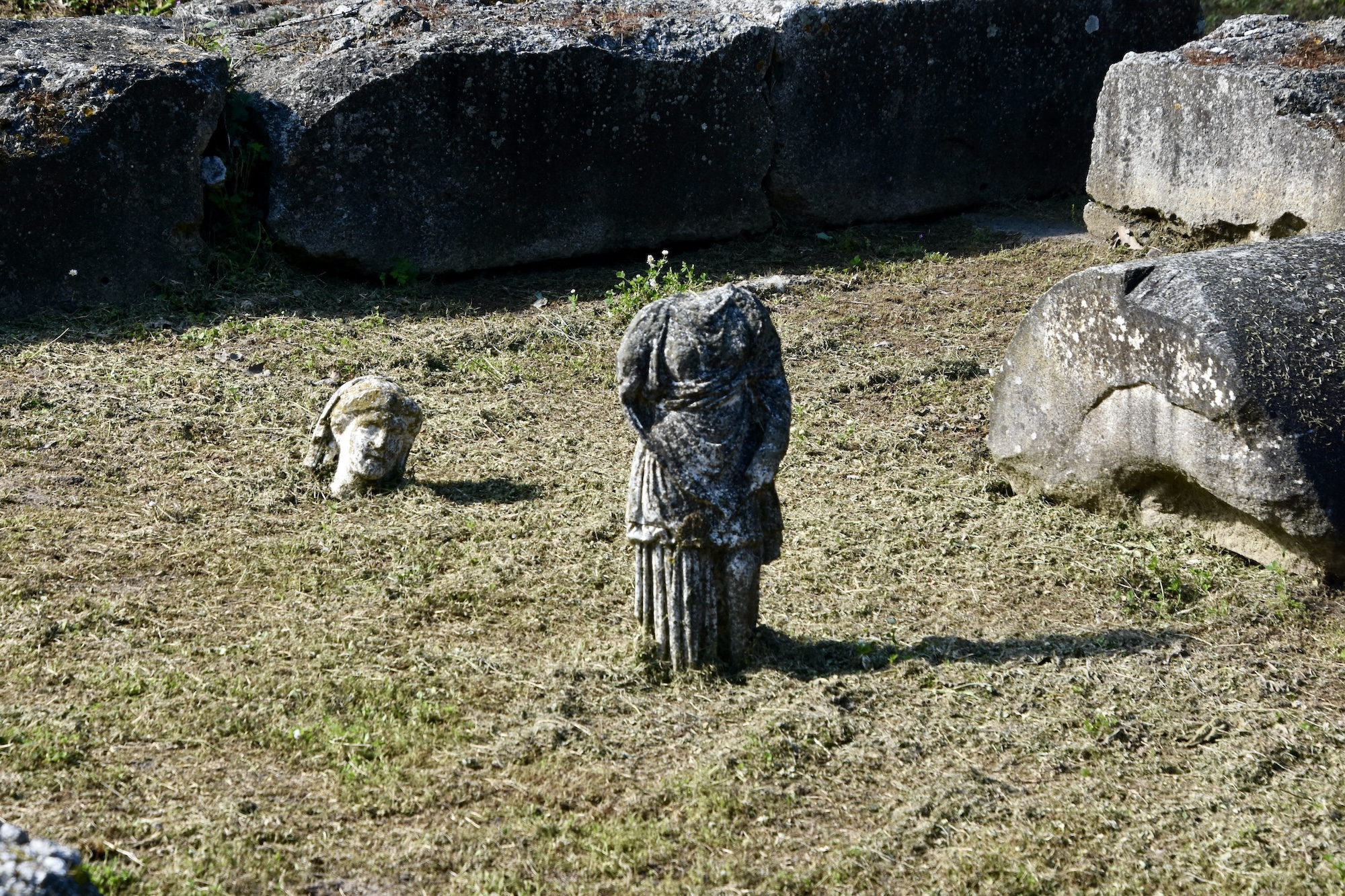
Next at Dion is the Sanctuary of Zeus Hypsistos which was actually a cult dedicated to Zeus as the ‘most high’ and about which little is known. Hypsistarians emerged rather late in Dion and some have described them as a combination of both pagan, Christian and Jewish beliefs which later transformed into pure Christianity. The death of the Olympians and the rise of Christianity took place over centuries and it’s quite plausible that the figure Zeus as the almighty god gradually came to be replaced by Jesus.
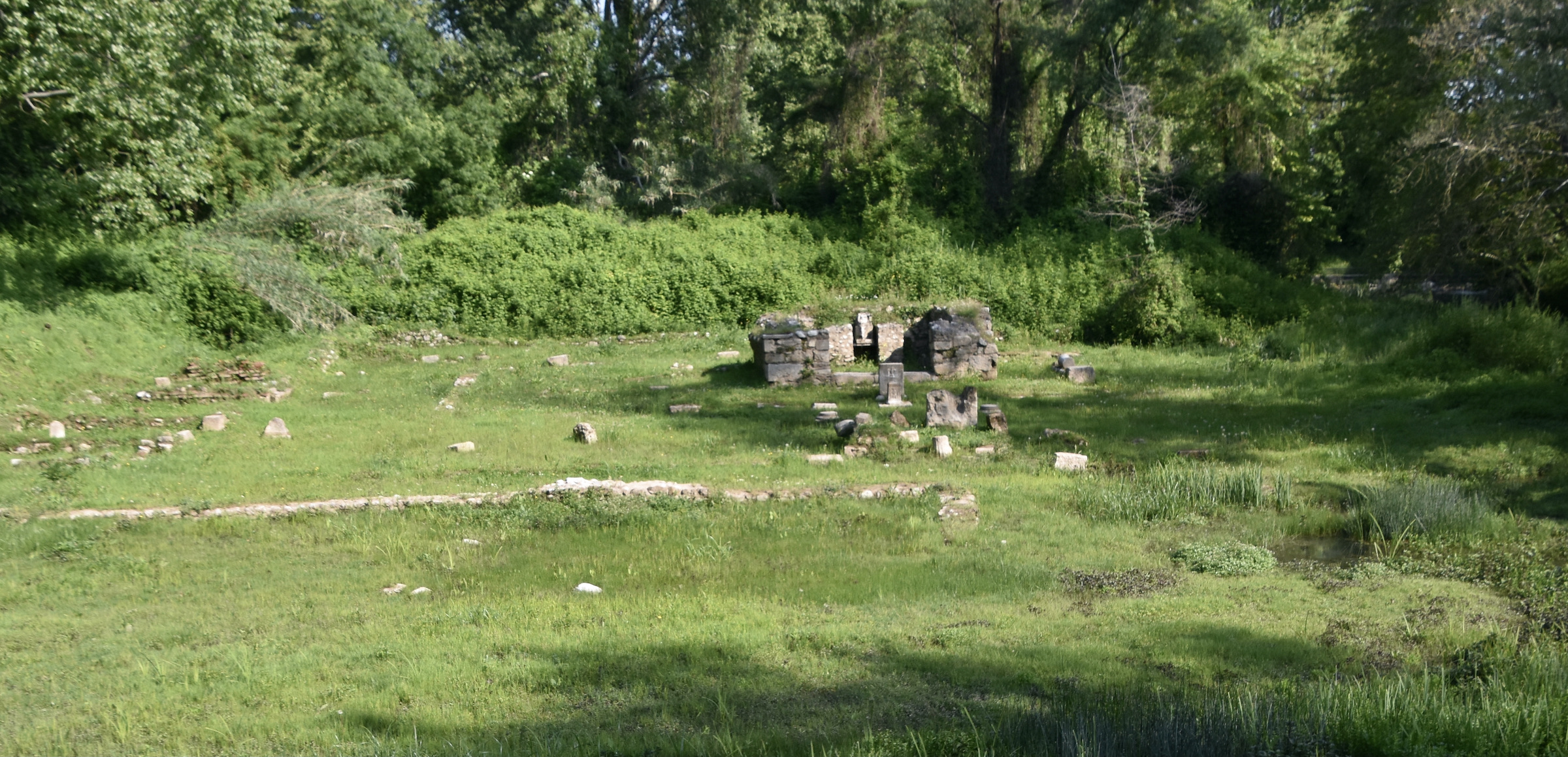
One of the most important artefacts unearthed at Dion was this statue of Zeus Hypsistos which was found at the back of the small temple that once stood here. Also found was a metal ring to which full grown oxen would be tied before being slain by an axe wielding supplicant. No piglets for Zeus.
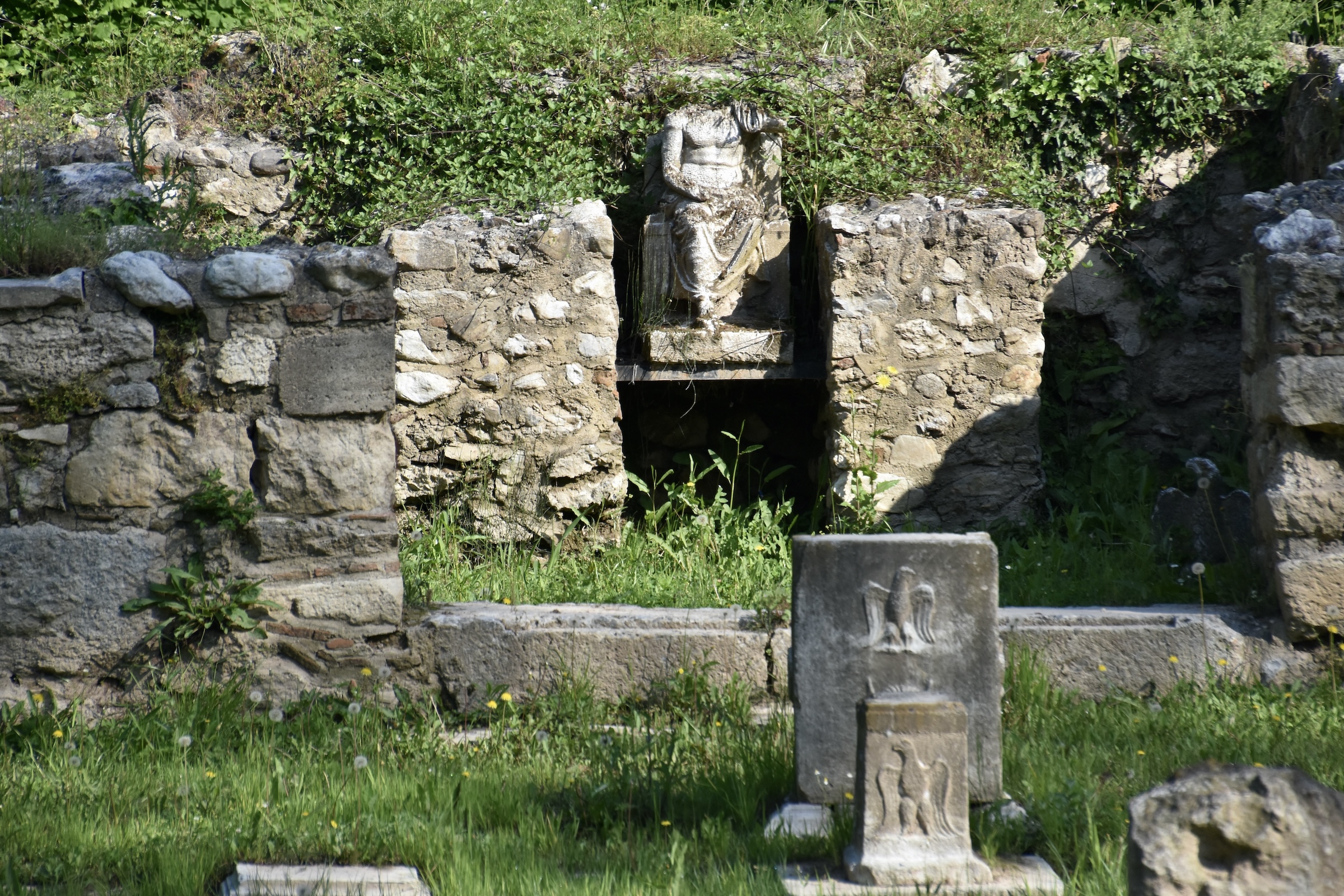
The river Vaphyras runs through the site of Dion and was the cause of the siltation. The name rang a bell with me. but I couldn’t place it until Nikos explained that this was the very spot where Orpheus was killed. Orpheus was the son of Apollo and one of the great figures of Greek mythology. He was the greatest poet, musician and singer in ancient times as well as being an Argonaut. When his wife Eurydice died he was given the honour of going to Hades to bring here back to earth on condition he not look back, but of course, like Lot’s wife he couldn’t resist and Eurydice was called back to Hades. After that Orpheus was a broken man and refused to play his sacred lyre which infuriated the Maenads, the wine mad female followers of Dionysius. It was at this very spot that they ripped him to shreds. His head was washed out to sea and eventually ended up on the shores of Lesbos while his lyre became a constellation.
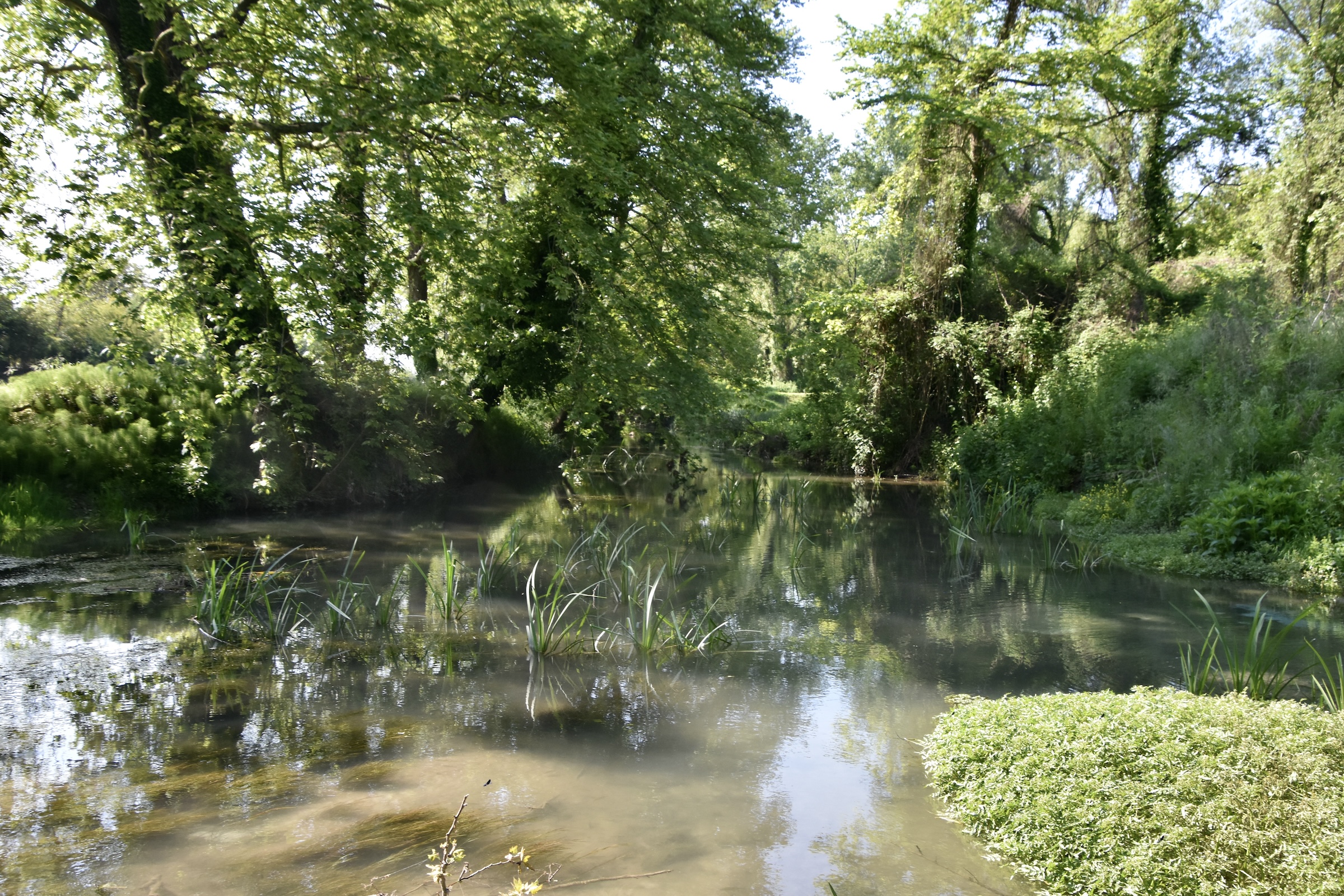
This definitely adds to the aura of mystery that shrouds Dion, but not in an eerie manner. In addition to the birdsong I mentioned before, I could now hear the thunderous chorus of hundreds of frogs. We now arrived at the Sanctuary of Isis, the Egyptian goddess whose worship spread throughout the Roman Empire after they occupied her home territory. Isis is associated with water and so it was perhaps not a surprise that her sanctuary was almost completely underwater.
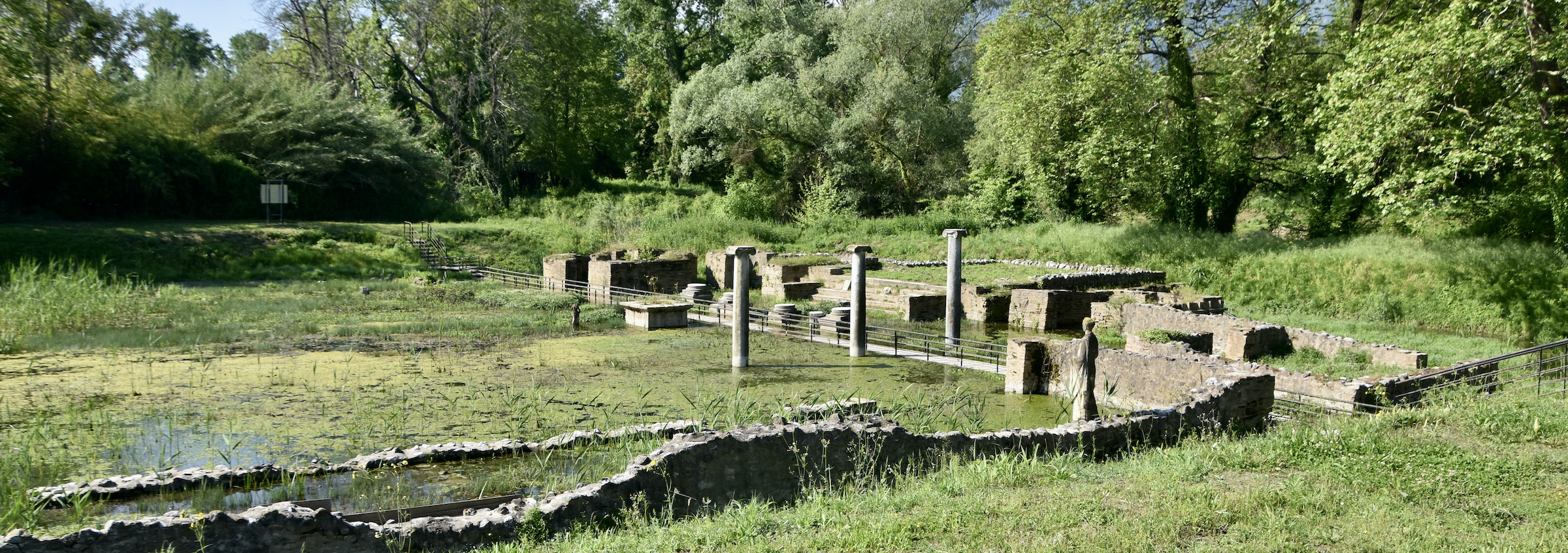
She was still being worshipped here, but it was by the common frogs that dwell here by the thousands. We’ve all heard that the number of amphibians is declining drastically, but someone forgot to tell that to these creatures. I’ve literally never seen more frogs in one place in my life.
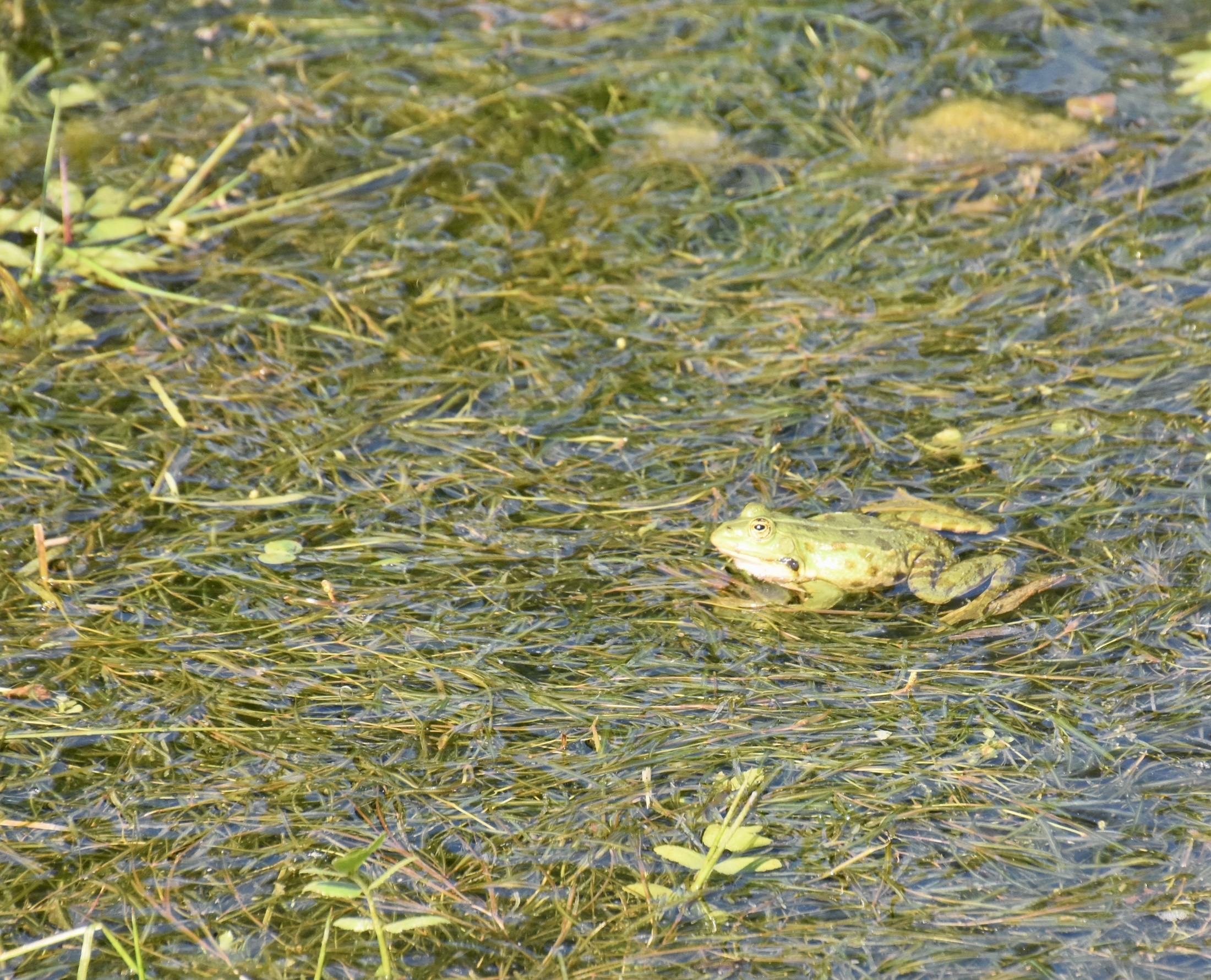
There is a half submerged wooden walkway that traverses the Sanctuary of Isis and from here you can get a closer look at her statue.
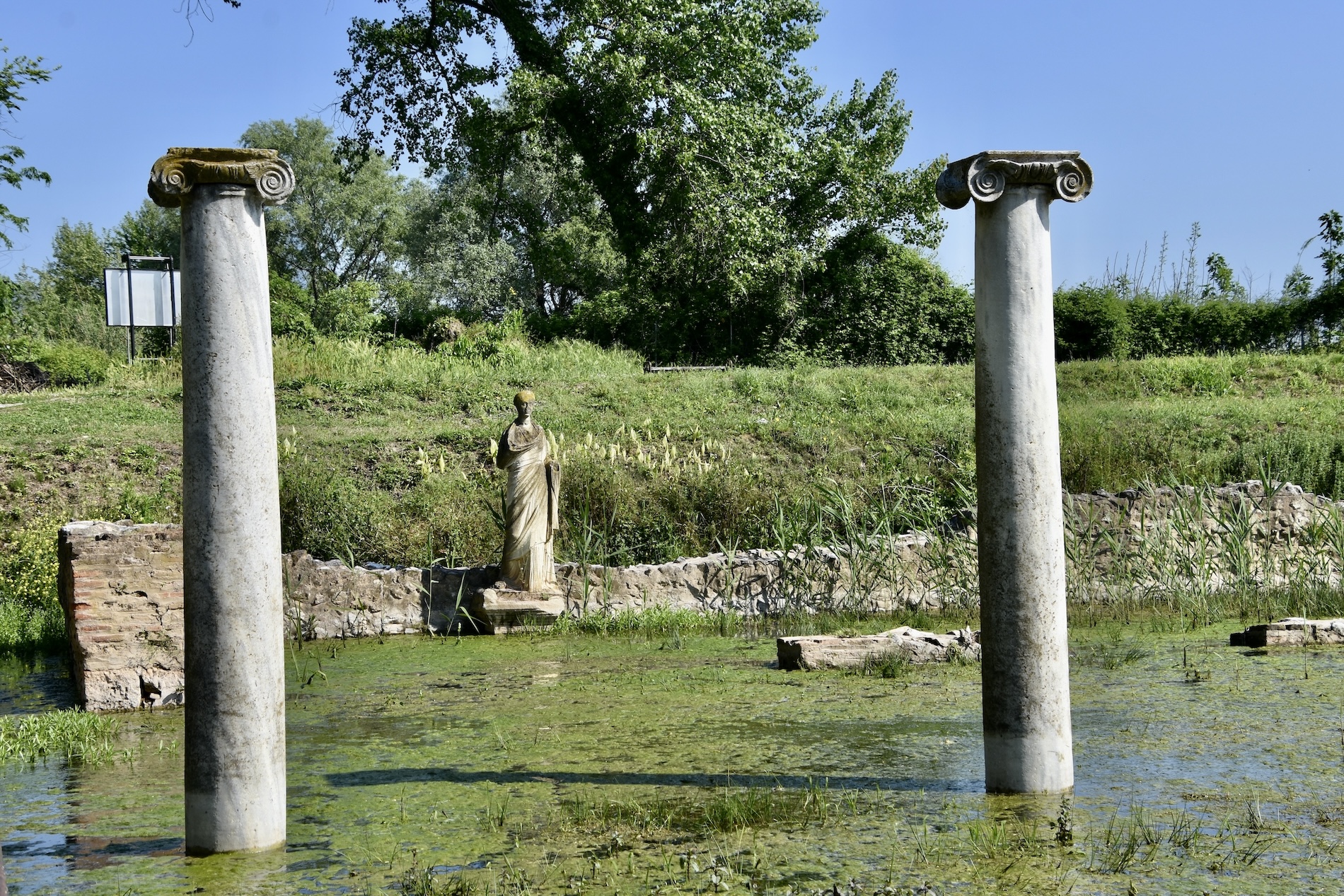
Isis was also a protector of children which explains the presence of this statue in this place. Leaving these statues exactly as they were found was a brilliant idea.
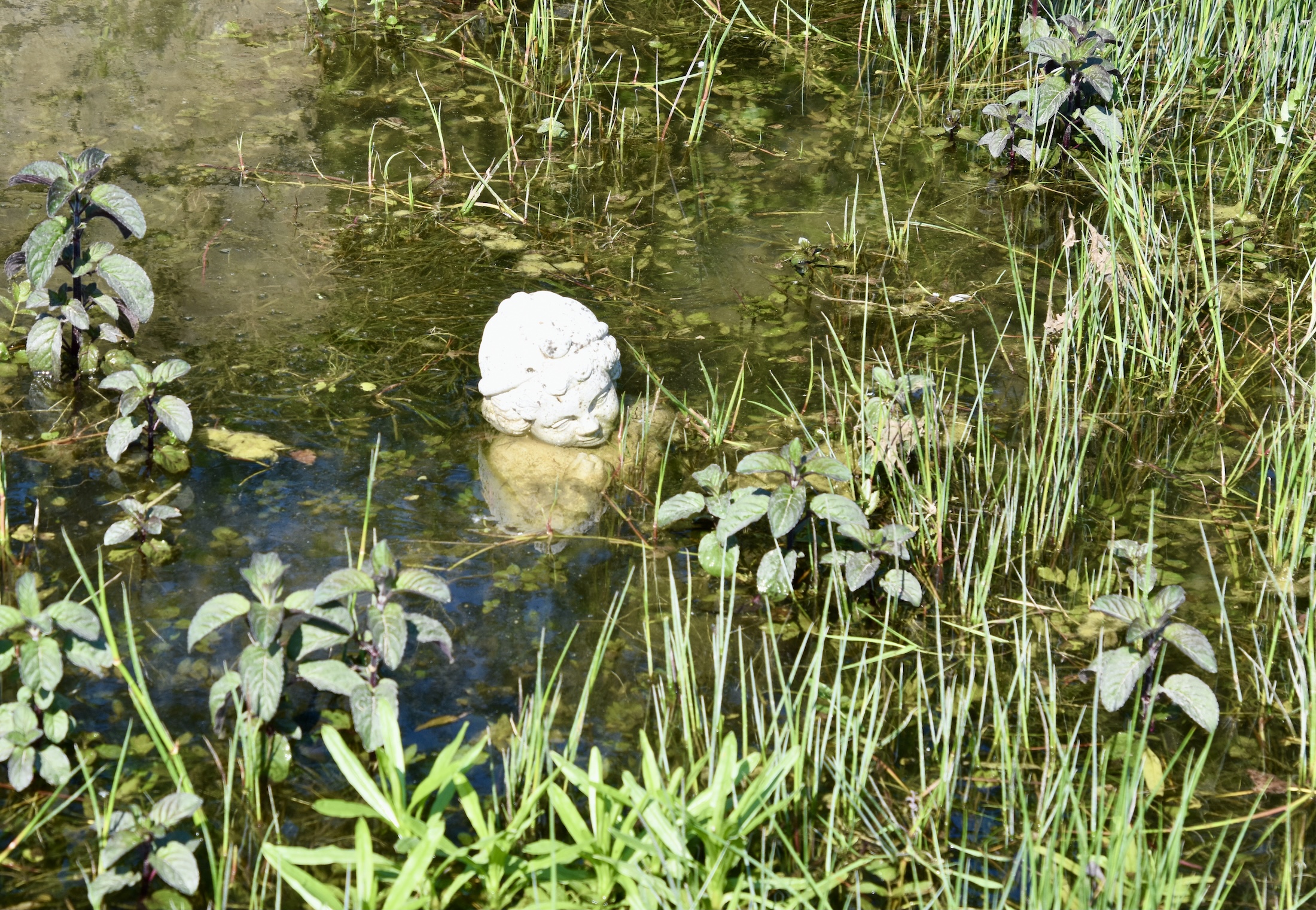
The path now leads us to the ruins of the Roman Dion with its straight streets, brick buildings, baths, small odeum and more statues in place. It’s not as interesting as the sanctuaries so I’ve included these in a gallery.
- Main Street
- Roman Statues
- Hypocausts
- Bull Mosaic
- Small Odeum
- Headless Statue
There are two more sanctuaries at Dion. This one almost hidden in the woods is to Asclepius, the god of healing and a common honoree at places like this. The sacrifices would be made in the hopes of getting a cure or some type of health remedy.
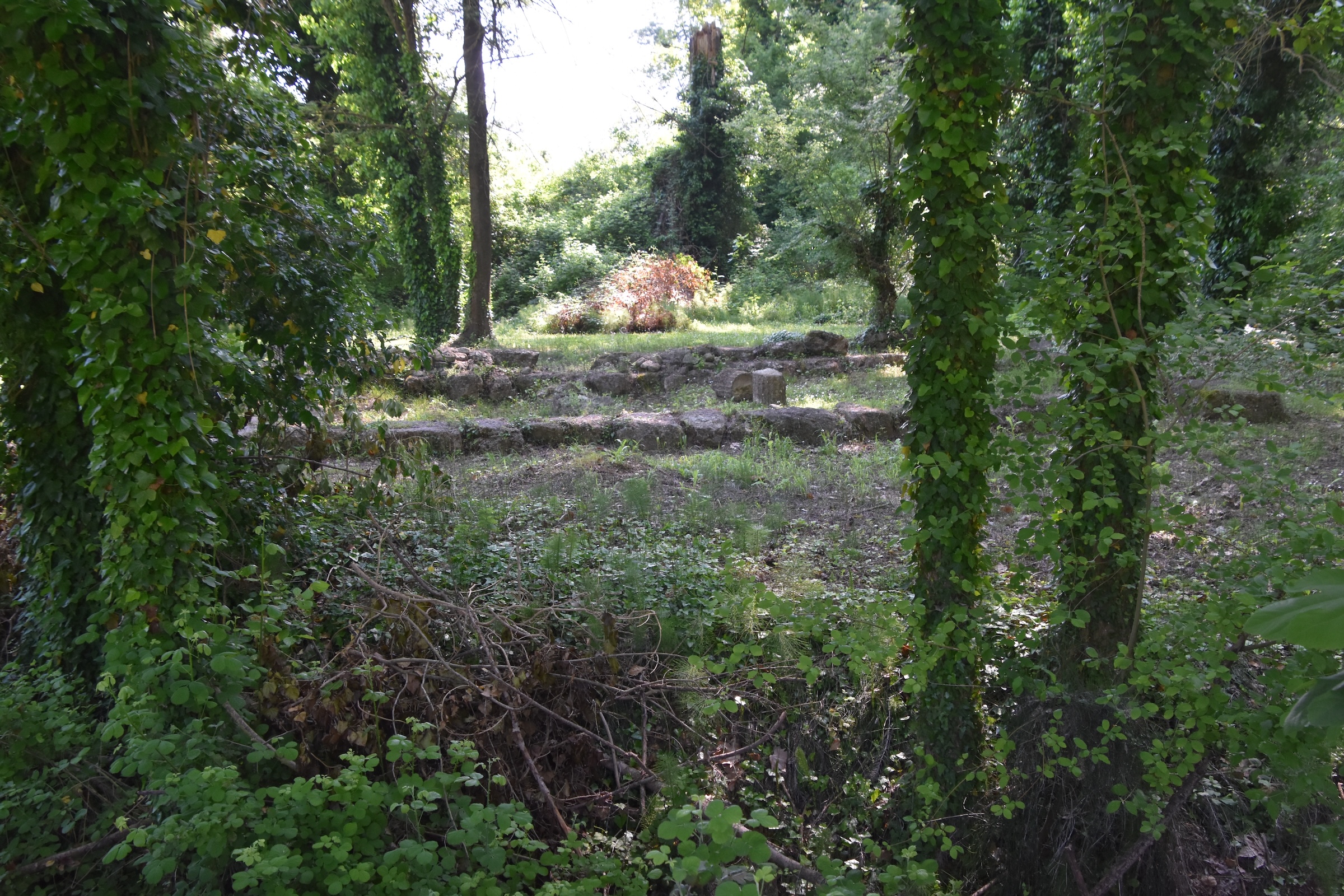
Lastly, there is the Sanctuary of Zeus Olympios, the largest and most important one at Dion. If you have read the Iliad you will be familiar with the word ‘hecatomb’ which means the sacrifice of a hundred oxen, which seems pretty gruesome.
Here at this sanctuary, which doesn’t look like much now, they actually did sacrifice a hecatomb of oxen on many occasions. It was on this spot that Alexander stood offering prayers to Zeus as he offered up his sacrifice. This was arguably the most important site in Macedonia and yet few people ever come here.
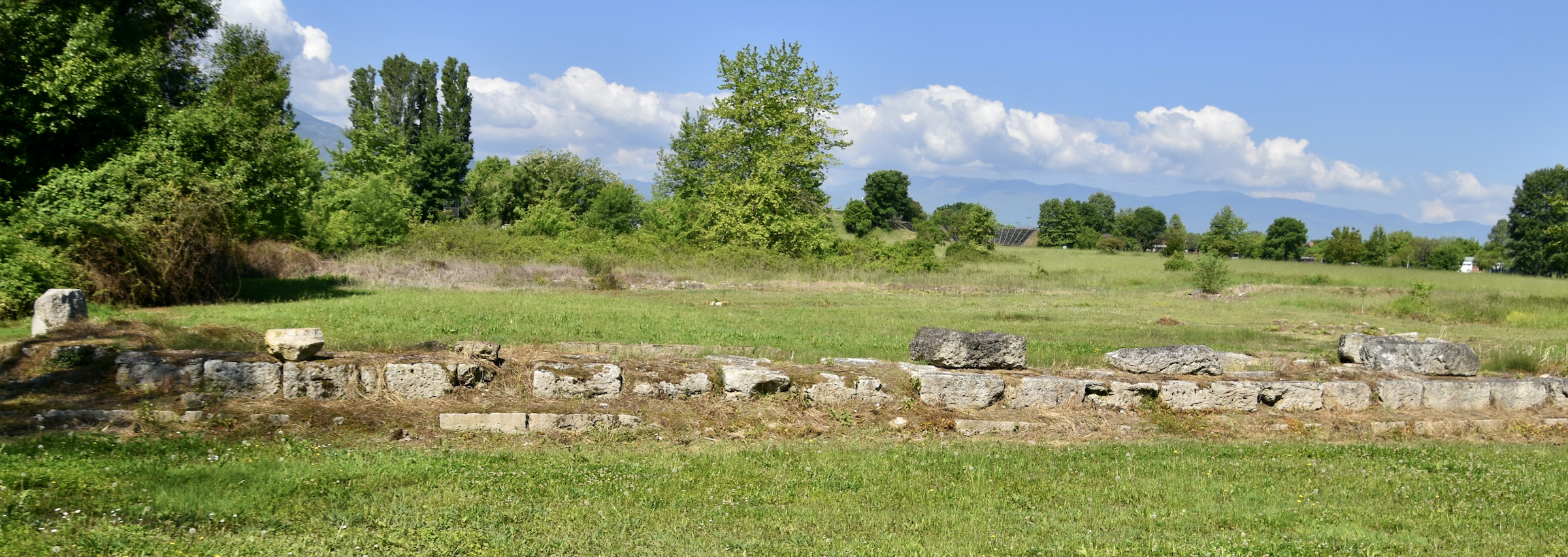
While we have seen the most sacred sites in Dion we have not yet seen the most majestic, which is the Hellenistic theatre with Mount Olympus as its backdrop. This has to be one of the great photo opportunities in the Greco-Roman world. Trust me, you will truly be wowed when you come across this at the end of your visit to Dion. Believe it or not this theatre was completely covered over until rediscovered in 1806 by an Englishman. It once debuted play by Euripides and since 1991 hosts them again at the annual Olympos festival.
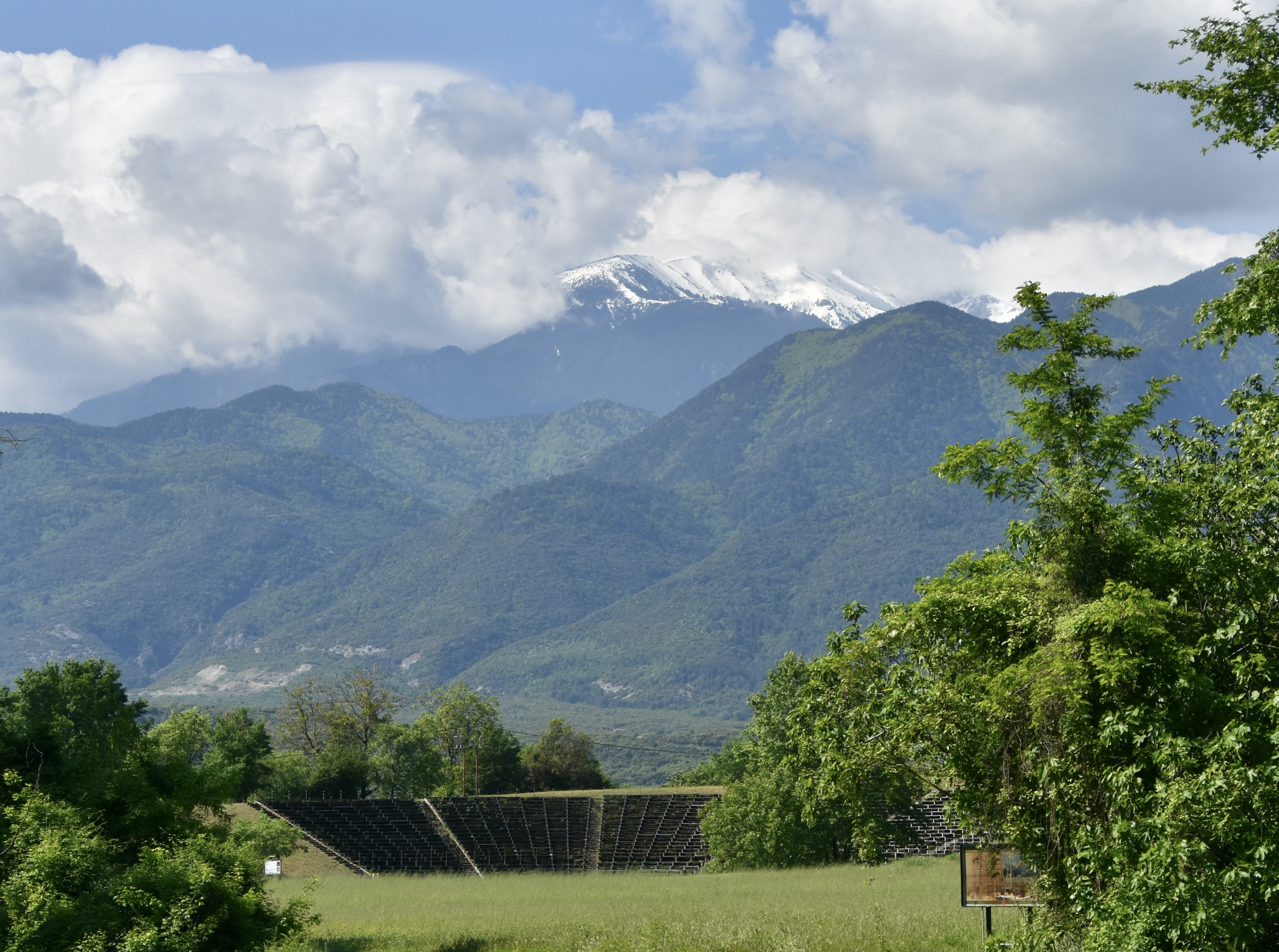
Time now to head the short distance to the museum.
The Archaeological Museum

The Dion Museum contains artefacts found at Dion and other sites around Mount Olympus. There is one building that was created just to house this massive mosaic depicting the Epiphany of Dionysius which was only discovered in 1987 and fully restored in 2015.
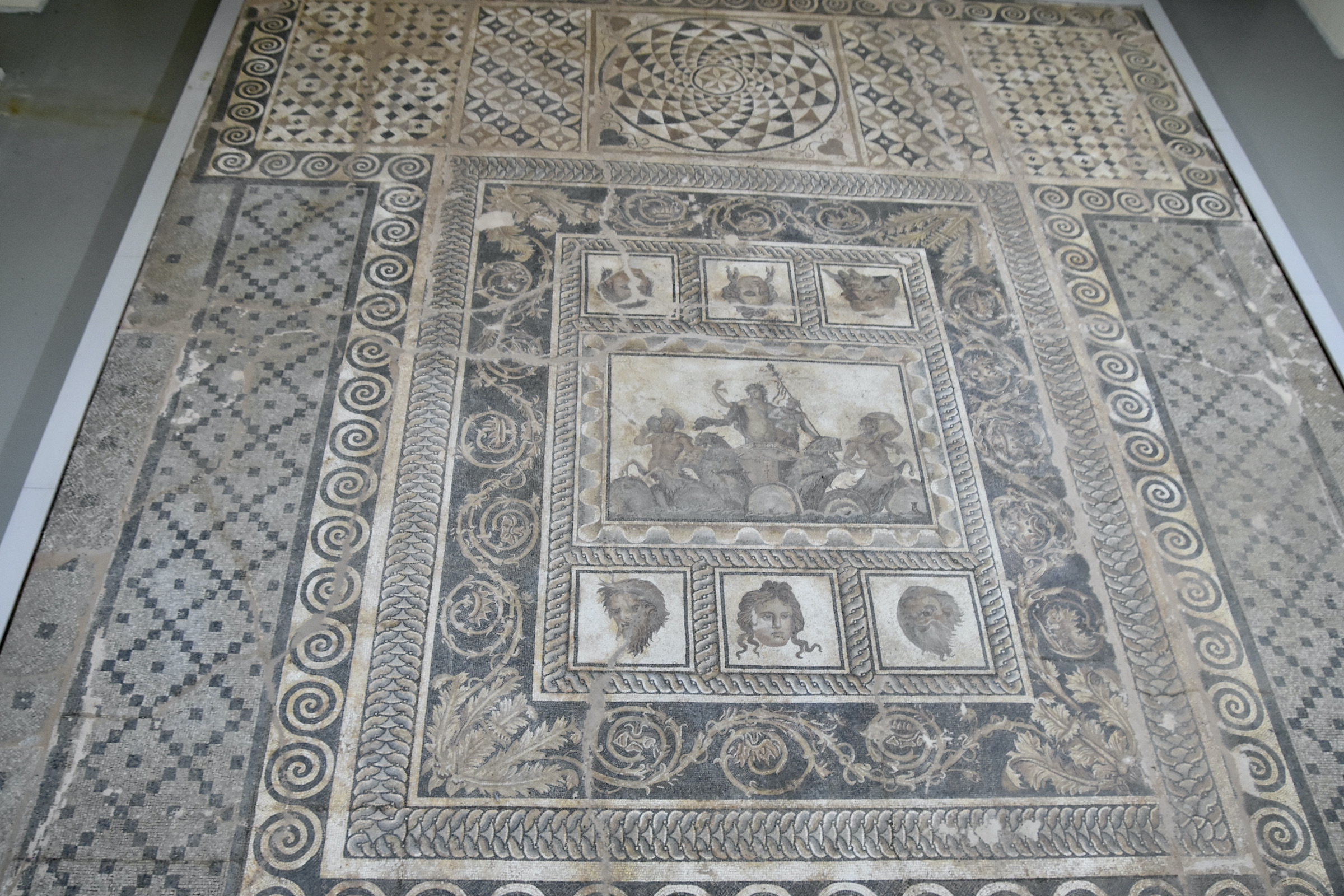
There are number of outstanding and totally unique items in the museum and I’ll end this to Dion by highlighting a few of them.
This is the original statue of Zeus Hypsistos that stood in his sanctuary.
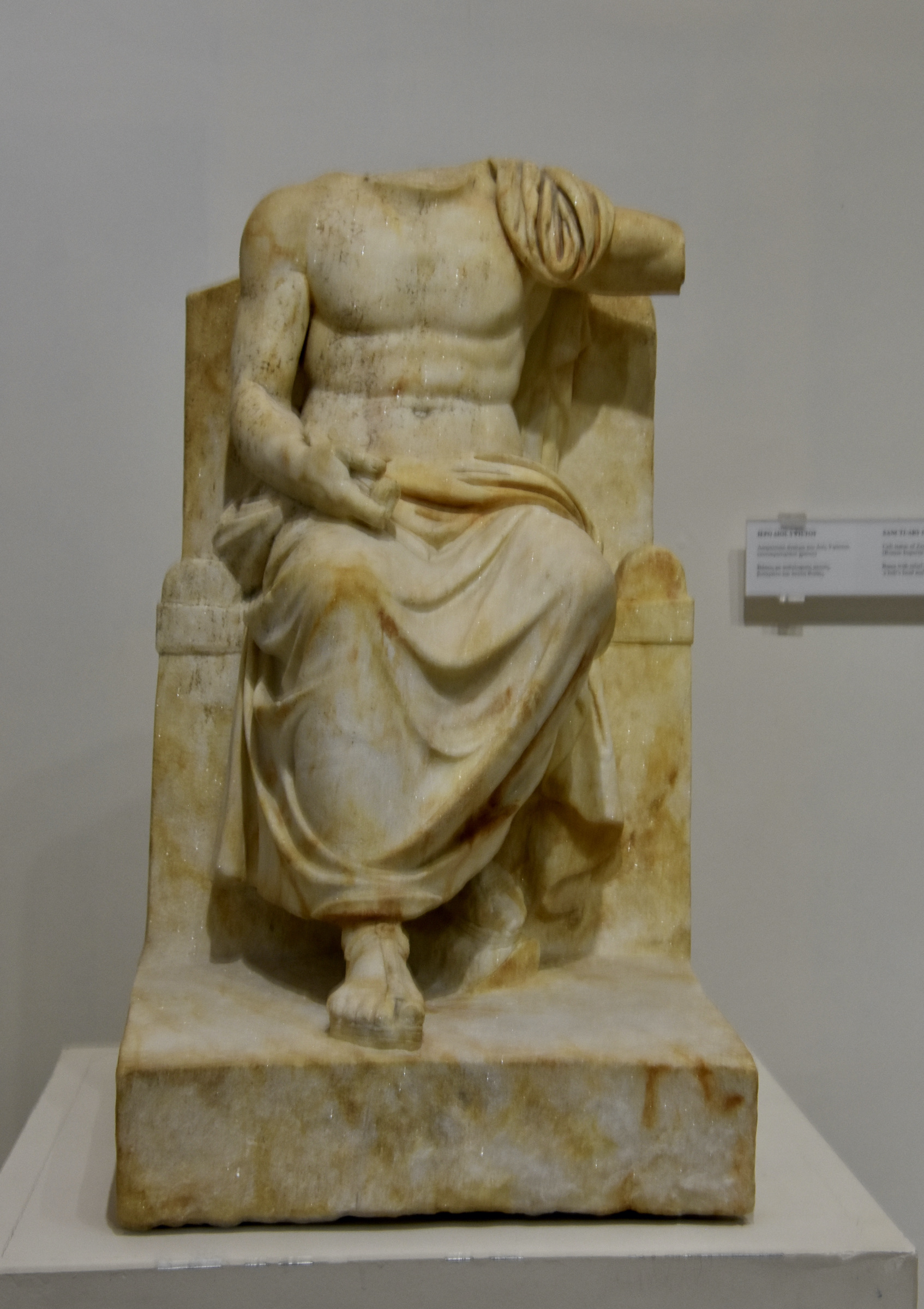
This is a herm which is a statue showing only the head and male genitals. They were considered good luck charms and placed in front of temples, at crossroads and street entrances. If you know your Peloponnesian War history you will recall the incident where all the herms of Athens were mutilated the night before the Athenian fleet was to set sail for Sicily. Alcibiades, the best Athenian general, was blamed and his probably wrongful conviction helped send the Athenians to total disaster at Syracuse. This herm too has been mutilated, but more likely by Christians than Greeks.
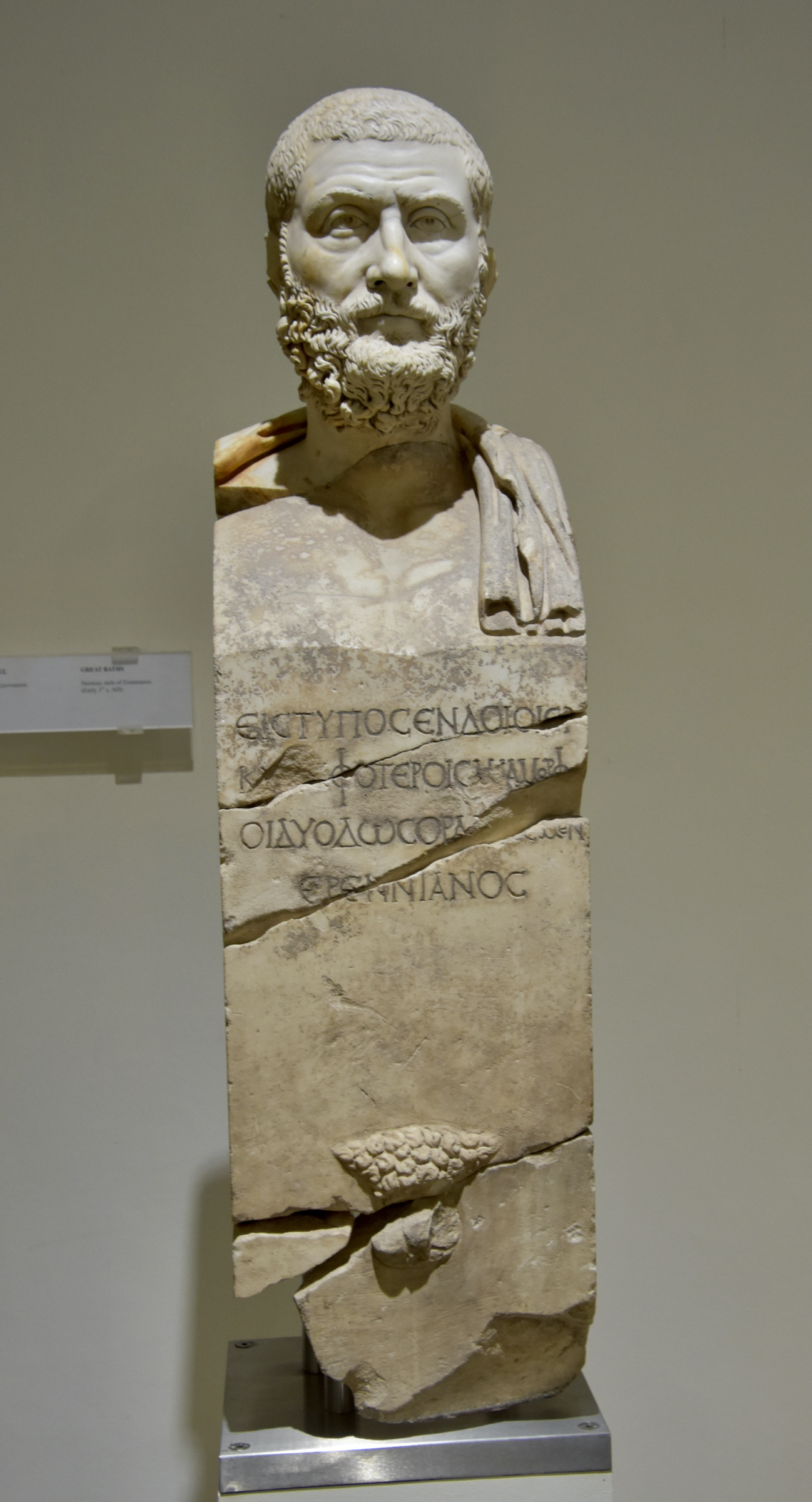
Zeus was always taking the form of something other than himself to seduce and/or rape his many victims, both male and female. None was more famous than his appearance as a swan before the Spartan queen Leda who had just slept with her husband Tyndareus. He raped her and the result was four offspring born at the same time, two from an egg and two more naturally. The progeny were Helen of Troy, Clytemnestra the future wife of Agamemnon and Castor and Pollux, the Gemini twins. The rape has been the subject of countless paintings (including two lost ones by Leonardo da Vince and Michaelangelo), sculptures, poems and plays. The one in the Dion museum is very graphic and violent with Leda doing her best to push off the attacking swan. It’s really quite disturbing.
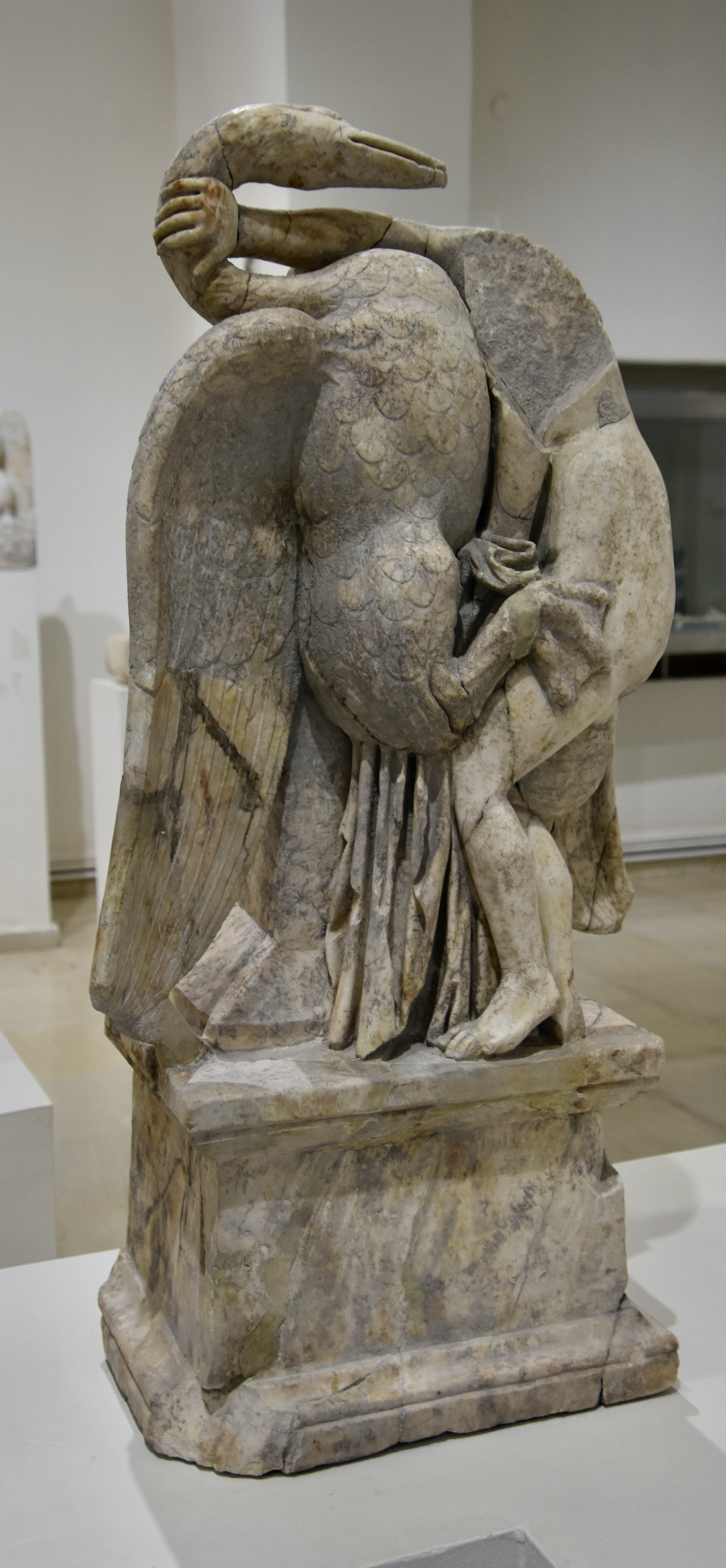
Now for some much rarer stuff starting with this head of an infant. Children were seldom the subject of Greco-Roman art and even less so a black child which many think this is.
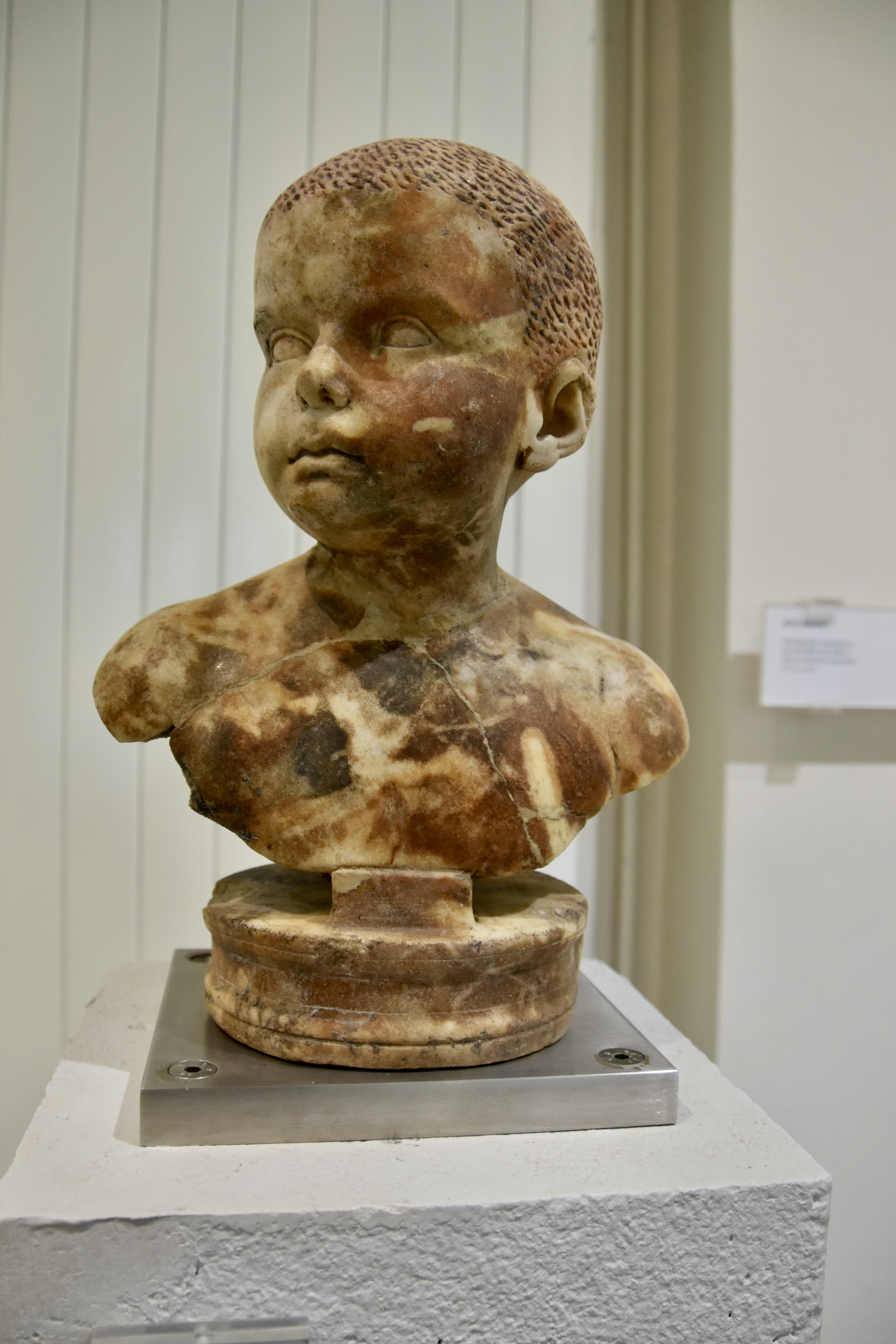
Now for something unique, the world’s oldest pipe organ.
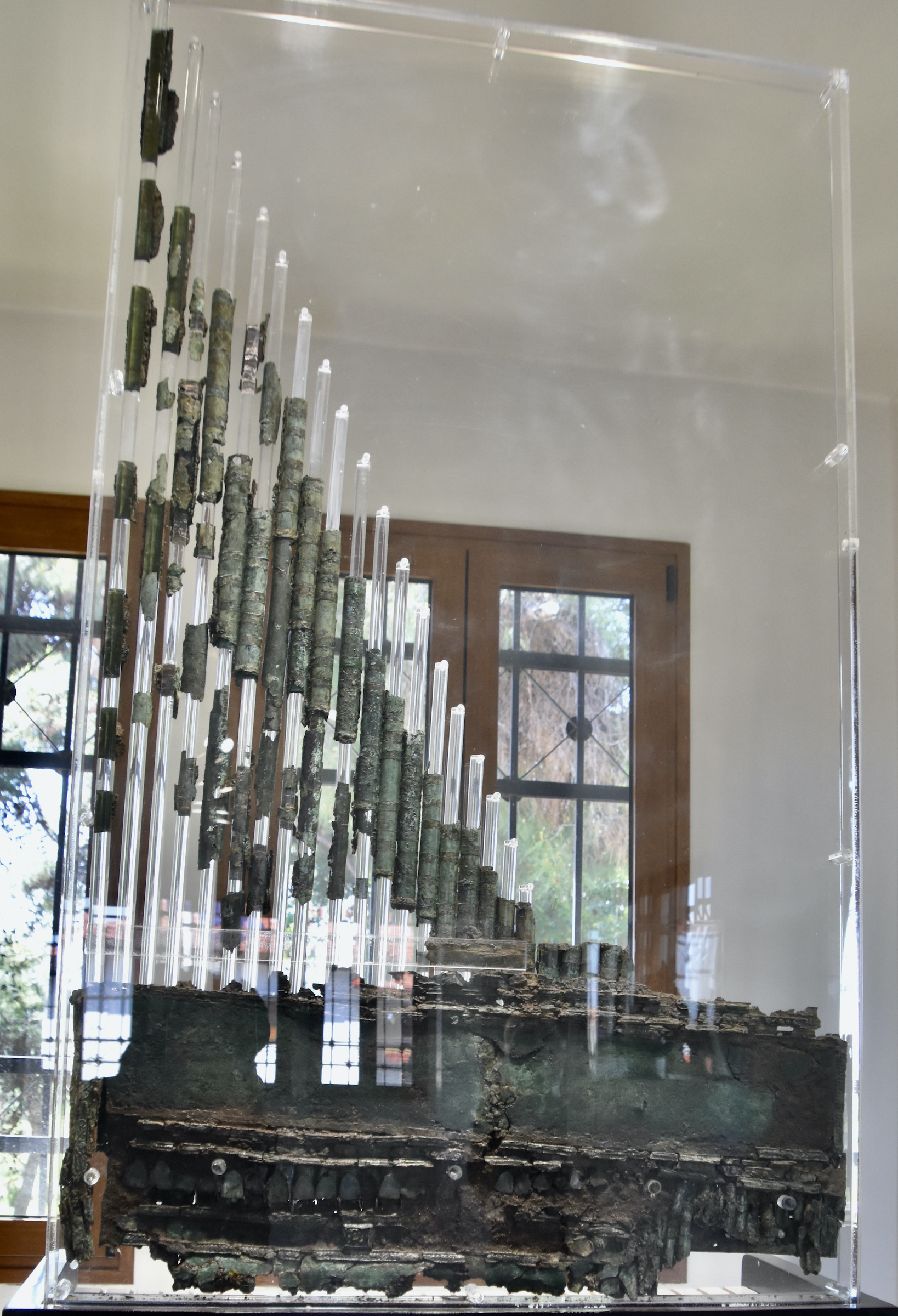
You probably thought I was kidding about this being a pipe organ, but in fact the pipe organ was invented in Alexandria in the 3rd century BC. This one, which even has its own wikipedia entry, is the oldest ever discovered. It was unearthed in many pieces near the same place as the Epiphany of Dionysius mosaic was found and it took a number of years for archaeologists to figure out what it was.
I had no idea that pipe organs were this old and that in fact they were played at Roman games much as they are today in NHL arenas. The things you learn from travel.
While you might know the sound of a pipe organ this next instrument you will not.
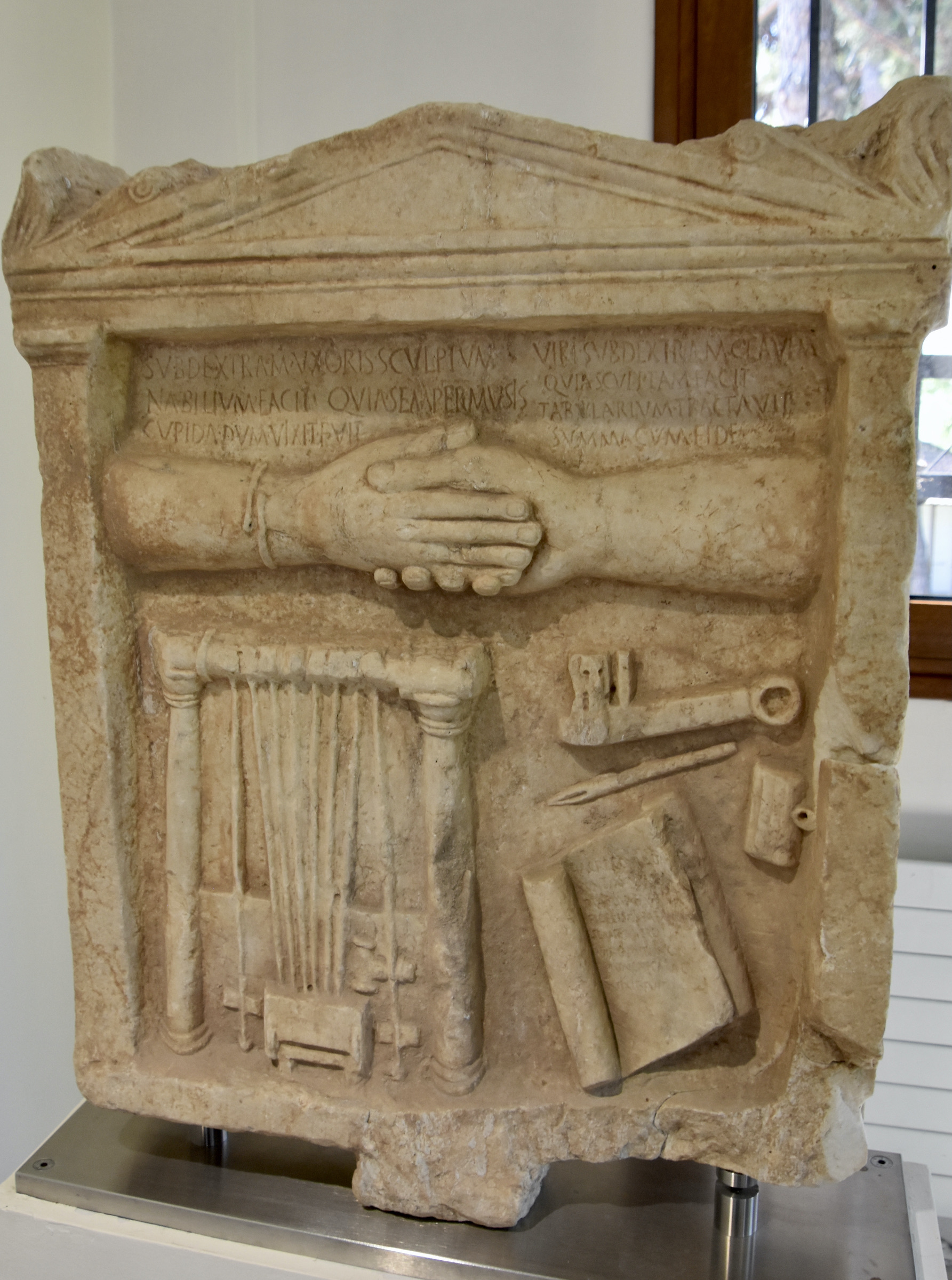
This stele portrays what archaeologists believe to be a musical instrument, but no actual trace of one has ever been found. How rare is that?
Lastly we have this, the skull of the sleeping girl. She was found in a very ancient tomb which also contained three Mycenean vessels which meant it was far, far older than the Macedonian tombs found in the area and raising a whole new question. Did the Mycenaeans get to northern Greece in the Bronze Age?
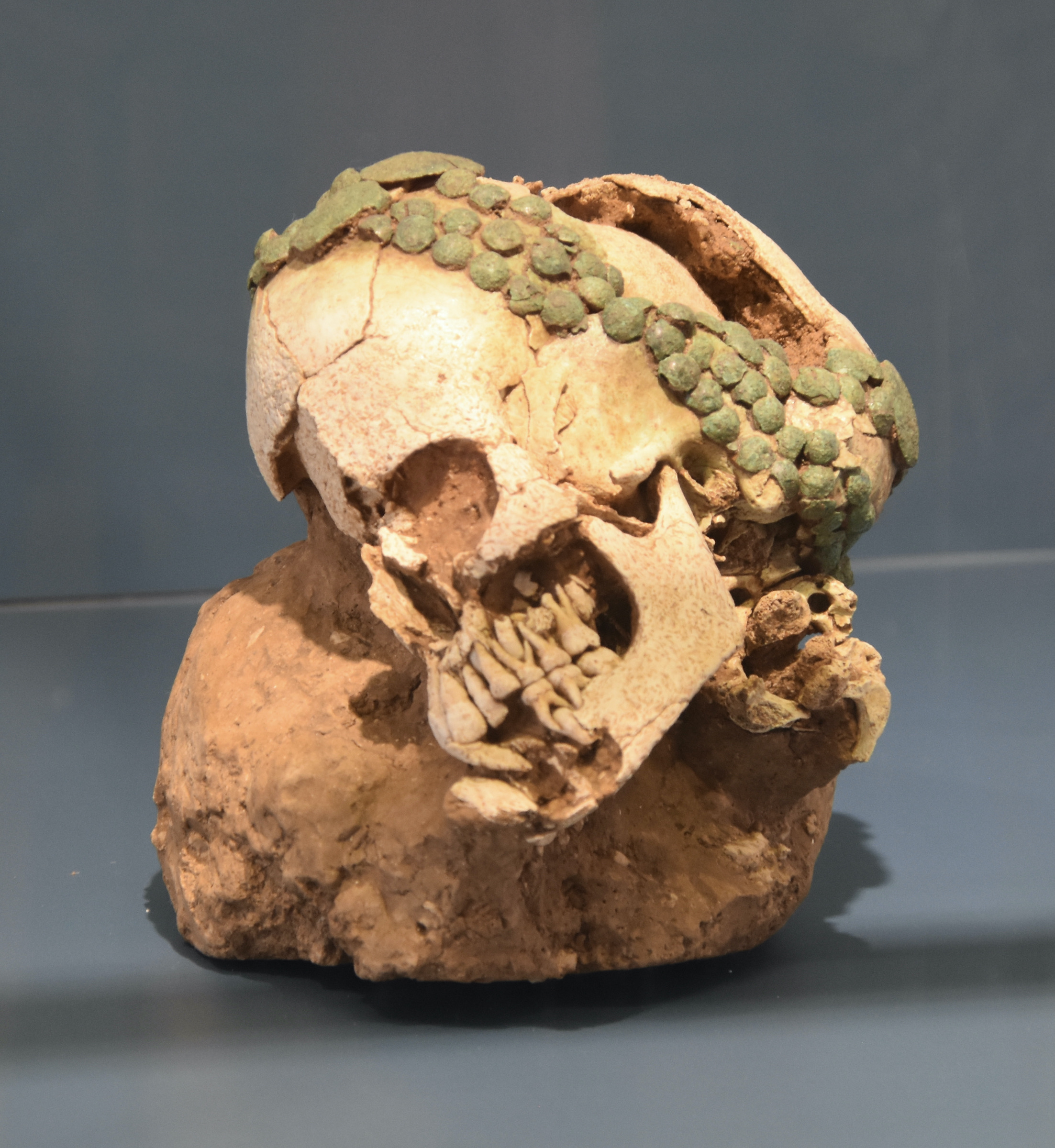
Well that concludes our visit to Dion, but the day is young and we are now headed to Mount Olympus for a picnic and a mountain hike.
Hiking Mount Olympus
As you can see from the photos of Mount Olympus its lower reaches are heavily forested and there are multiple valleys that have been carved by rivers and streams running down from the mountain. From Dion we take a narrow, winding road that ends at a barrier which is the entrance to the national park from where serious hikers begin the two day assent to the summit. We are not that quite ambitious and sit down to a nice picnic lunch before beginning our hike.
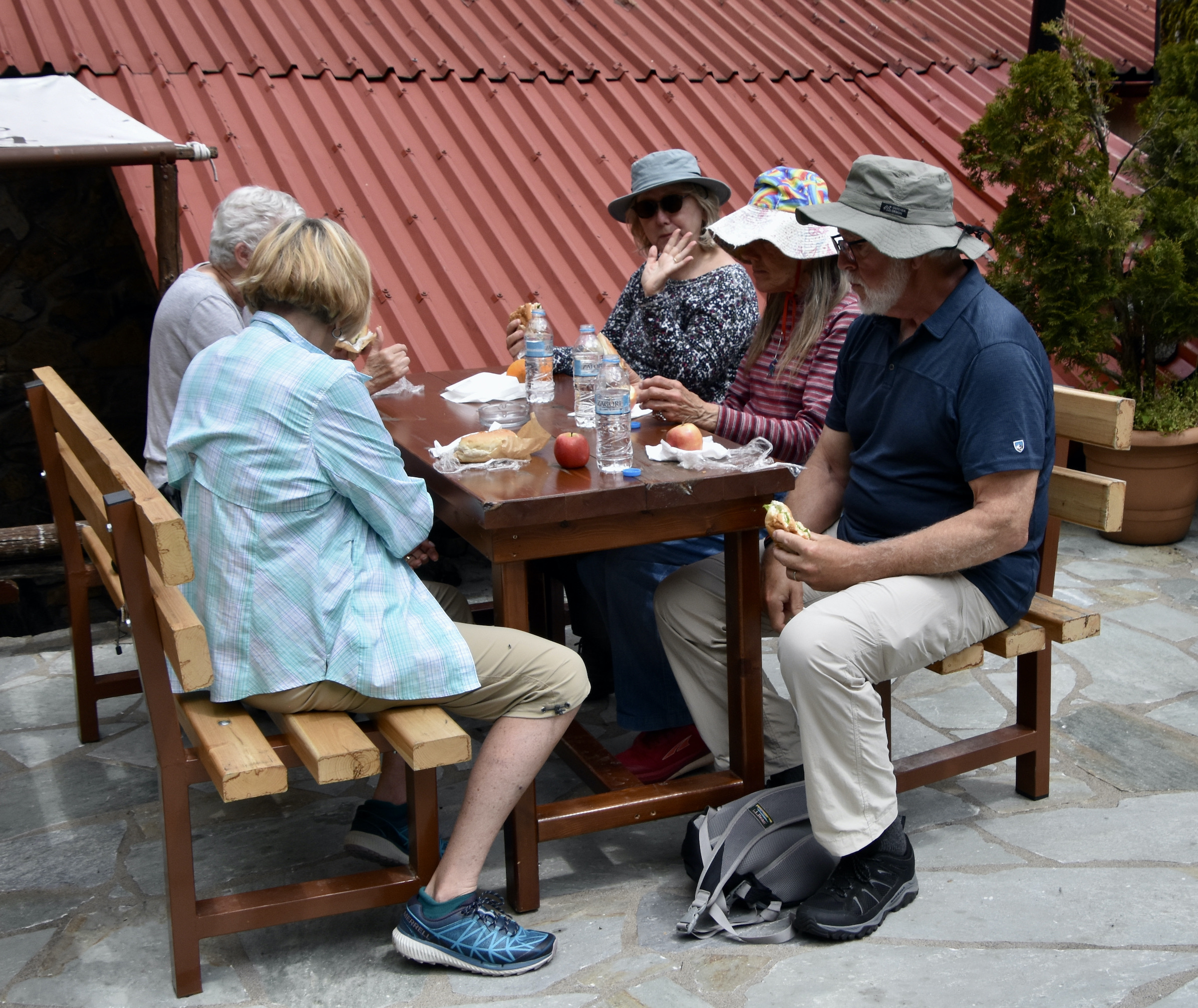
Instead of hiking up we will be heading down to an old monastery taking a path that follows the course of a small stream. Victor has secured the services of a local guide to lead the way.
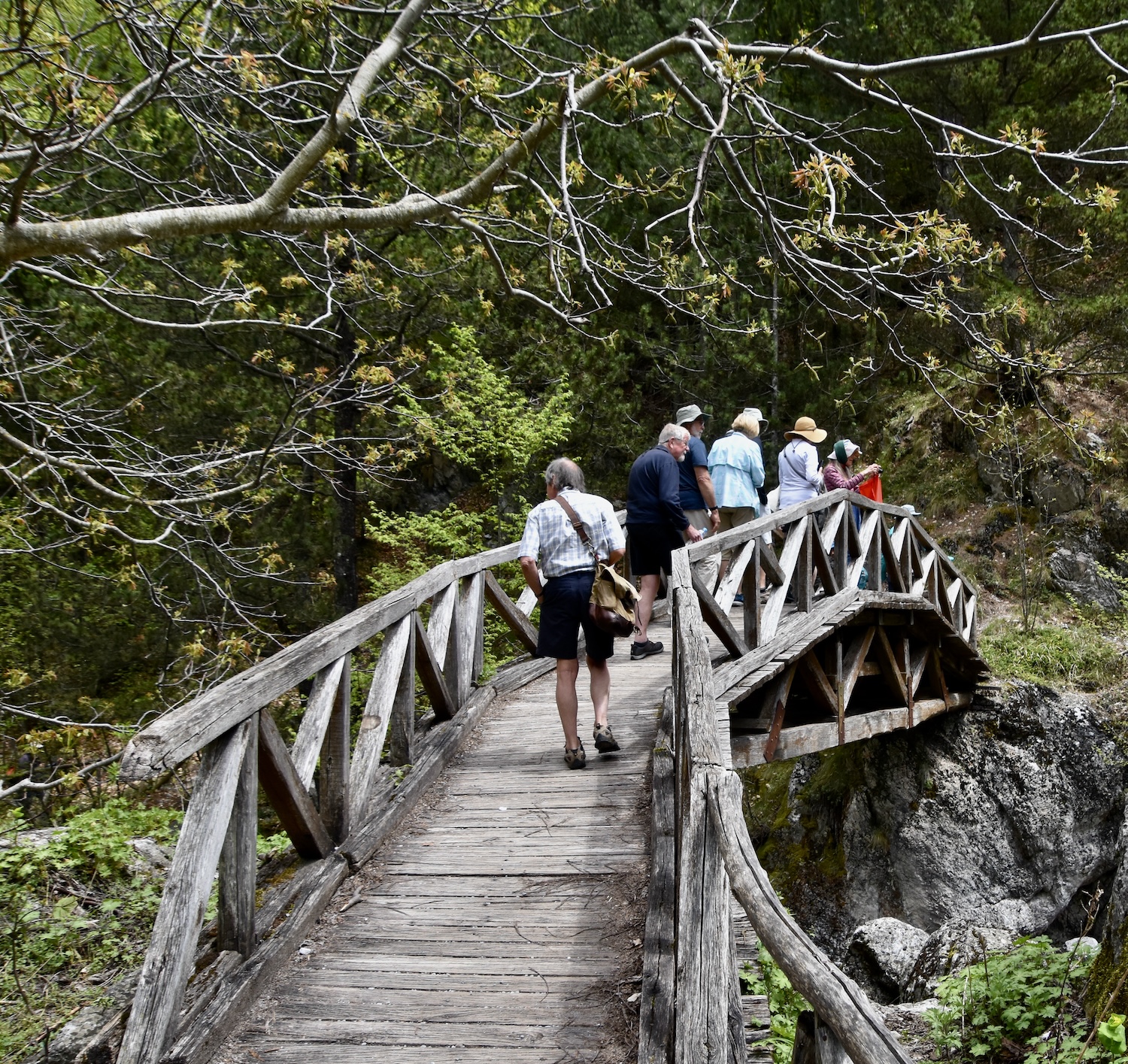
The walking is not overly strenuous, but does require keeping your eyes open for roots and rocks that might give you a tumble. Luckily no one does.
Overall all it’s a very sylvan experience this hiking through the woods and crossing streams on the side of a mountain where the Greek gods preside at the top. I could just imagine coming upon a naiad in one of these clear pools.
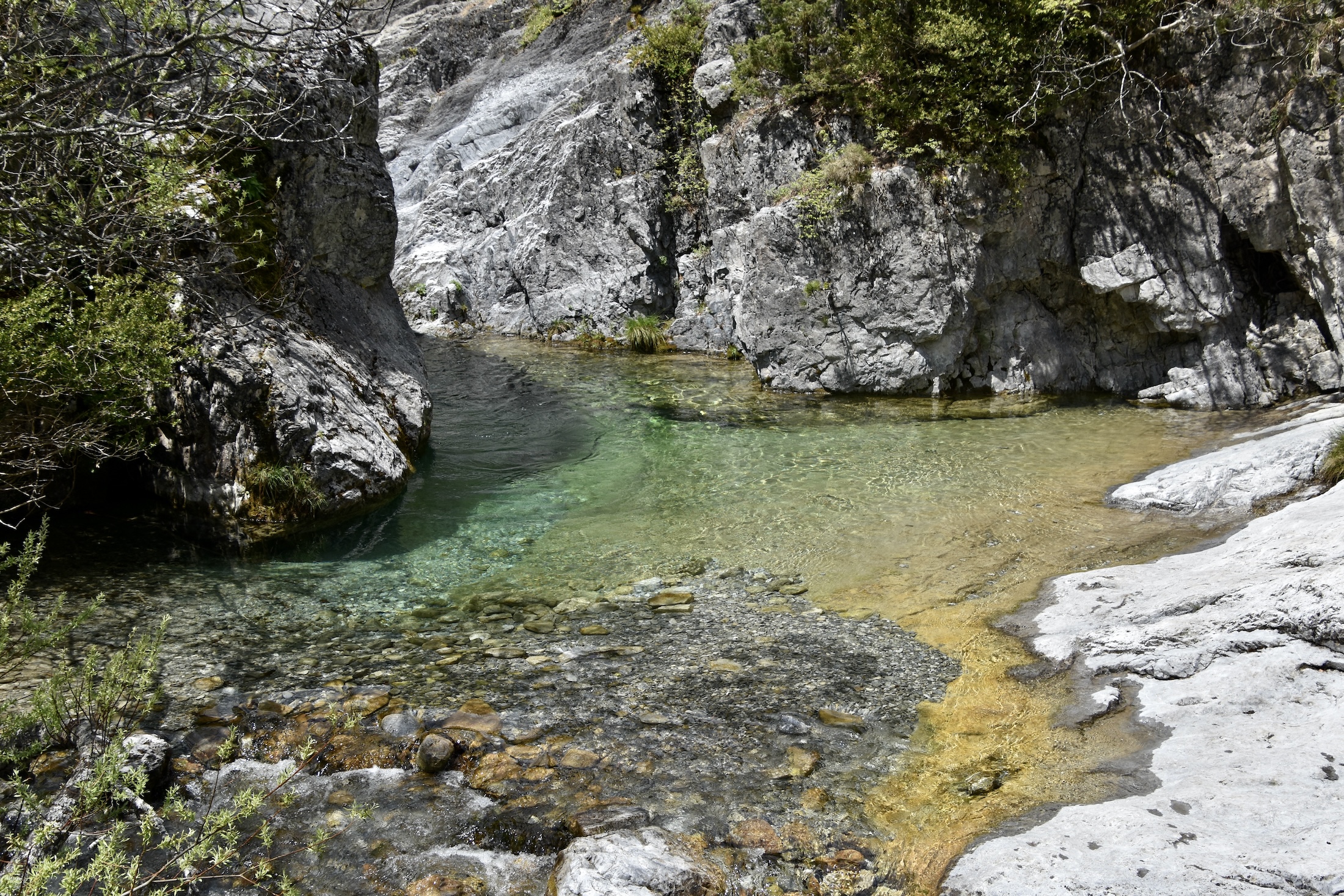
Or behind this waterfall.
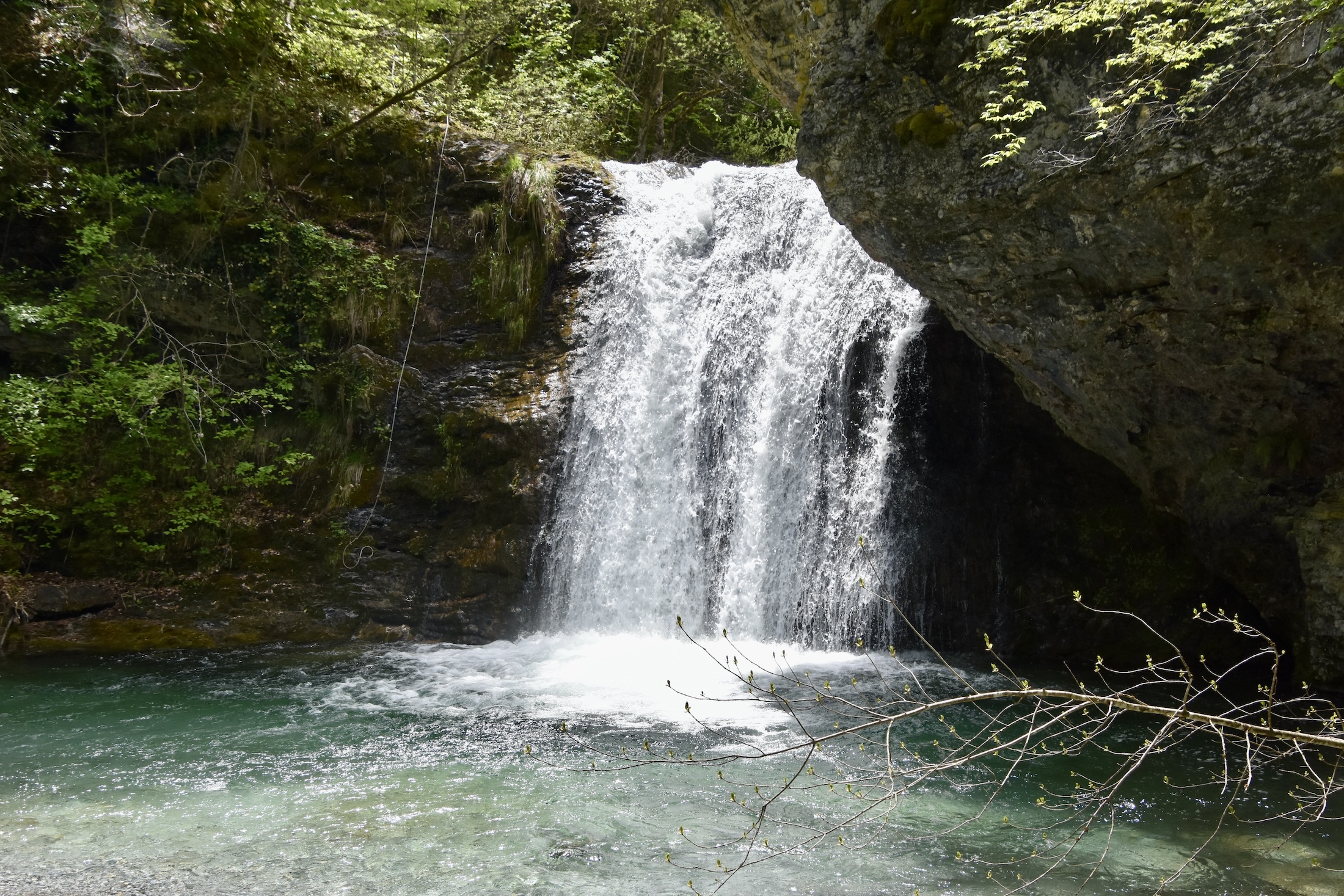
The hike lasts about an hour and a half before arriving at the Monastery of St. Dionysius which was founded by St. Dionysius Olympos in 1542. It was deliberately destroyed in 1943 by the Germans to prevent its use by partisans who were using the Mount Olympus area as their base. It is still in the process of being restored. From one mad megalomaniac to another, I couldn’t help but be reminded of what the Russians are doing today in Ukraine.
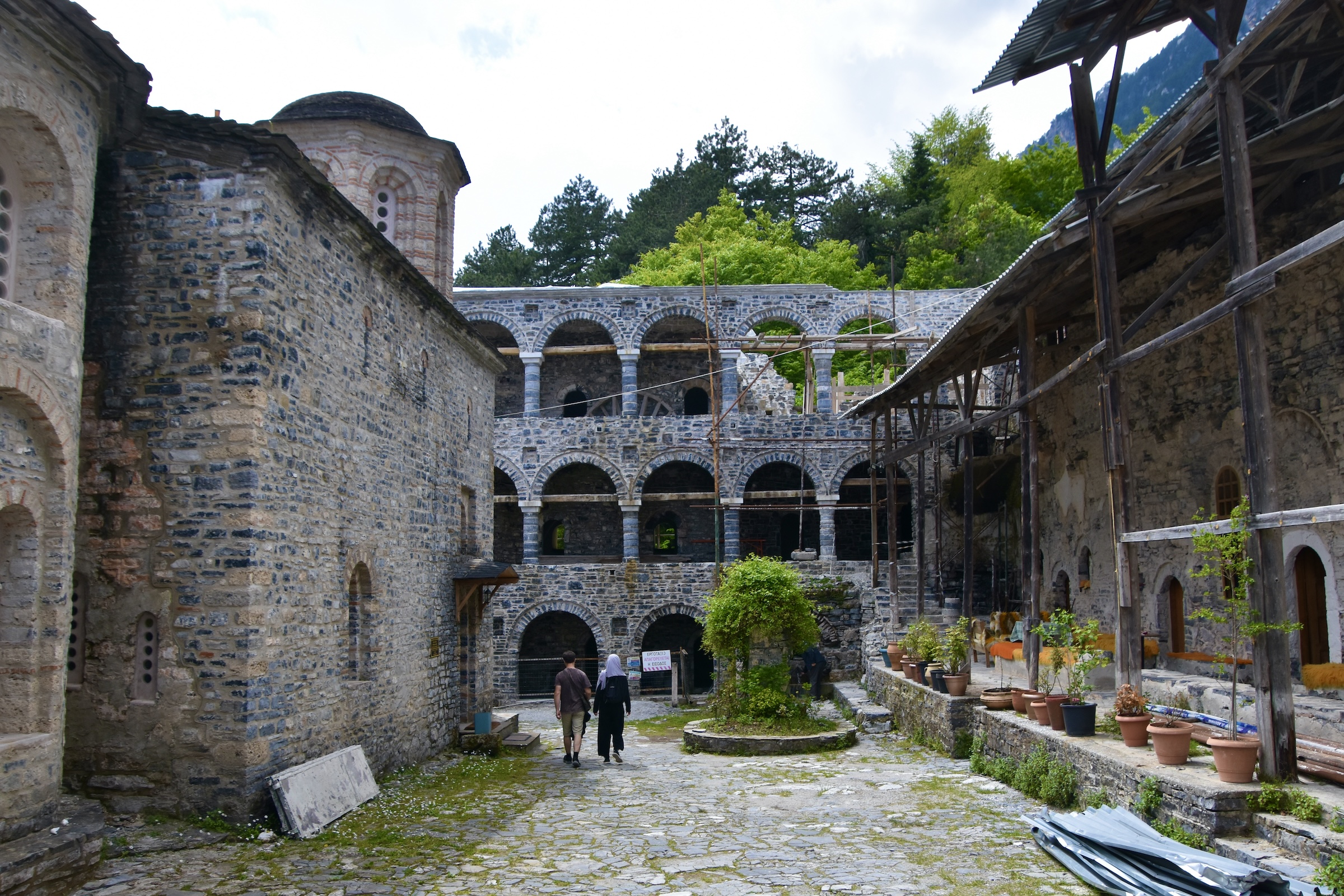
We ended our day exploring Dion and Mount Olympus back at the mountain retreat relaxing, doing some birding and just enjoying life in general. Tomorrow we will head to the city of Kastoria, famed for its beautiful lake and its furs, while stopping to view the monasteries of Meteora on the way. I hope you’ll join us.


